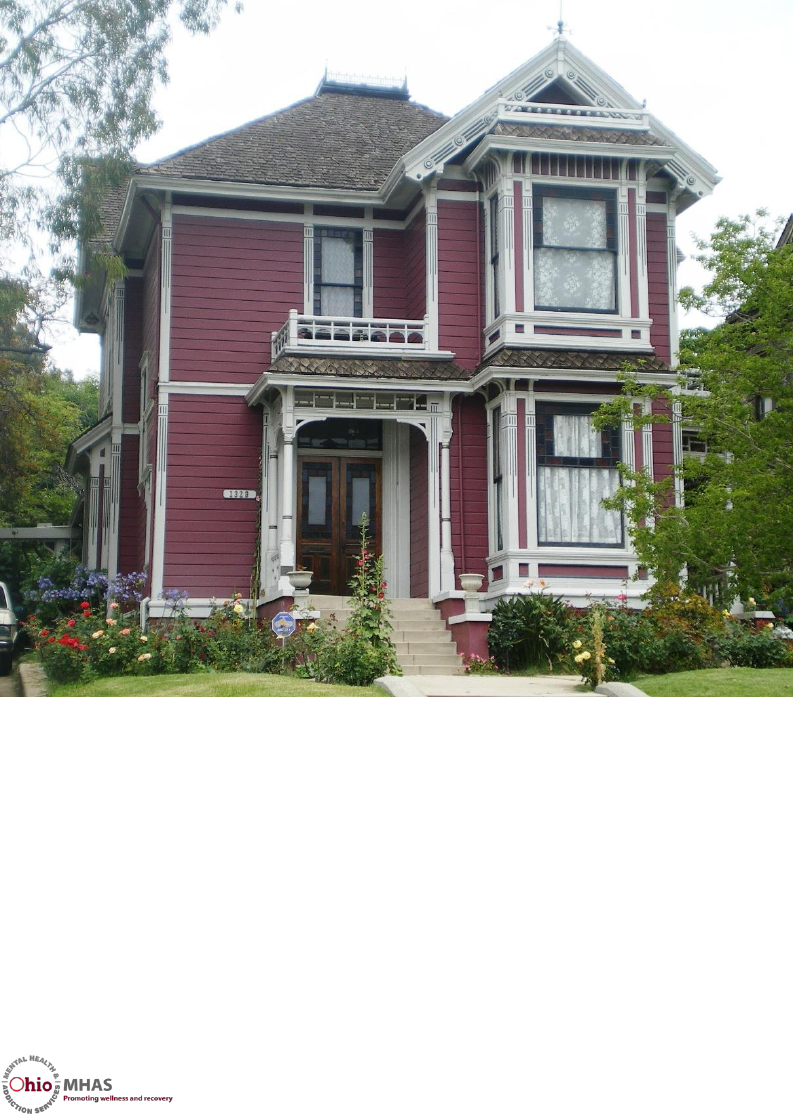
Small Business Toolkit for Adult Care Facilities Ohio Mental Health & Addiction Services Page 1 of 72
Starting Your Ohio Adult
Care Facility
Small Business Toolkit
Published August 10, 2017
Disclaimer: This document was prepared by Communities Unlimited in cooperation with
Ohio Mental Health & Addiction Services as a tool in assisting those starting and
operating an Adult Care Facility. This document is informational only and not to be
considered as professional business advice.

Small Business Toolkit for Adult Care Facilities Ohio Mental Health & Addiction Services Page 2 of 72
Table of Contents
ABOUT ADULT CARE FACILITIES .................................................................. 4
What is an Adult Care Facility? ....................................................................................... 5
Learn the Adult Care Facility Terminology ...................................................................... 5
The Assistance Required for Residents ........................................................................... 9
Average Business Startup Costs .................................................................................... 10
BUSINESS PLAN DEVELOPMENT .................................................................. 12
GETTING YOUR HOME LICENSED ................................................................ 13
Contact the Department of Building and Zoning Services ............................................ 13
Apply for Your Adult Care Facility License .................................................................... 13
Prepare for Licensing with the OhioMHAS Pre-Application Checklists ........................ 15
.................................................................................................................................. 16
Pre-application Checklist 3 to 5 bed home ............................................................... 16
Pre-application Checklist 6 to 16 bed group home .................................................. 19
LEARN WHO TO CONTACT WITH QUESTIONS .......................................... 22
BUSINESS STARTUP ......................................................................................... 23
Business Legal Structure ........................................................................................... 24
Obtain Your Employer Identification Number (EIN) ..................................................... 27
Register Your Business Name ....................................................................................... 28
Open a Business Bank Account ..................................................................................... 29
Obtain Adequate Insurance .......................................................................................... 30
Automobile insurance ............................................................................................... 30
Homeowner’s insurance ........................................................................................... 30
General liability insurance ........................................................................................ 31
Health insurance ....................................................................................................... 31
Workers’ compensation insurance ........................................................................... 32
Obtain your OhioMHAS OAKS Vendor ID Number ....................................................... 32
ORGANIZE YOUR BUSINESS .......................................................................... 33
Setup a Filing System .................................................................................................... 33
Develop Your Business Forms ....................................................................................... 35
Resident Information Form ....................................................................................... 35
Resident Agreement ................................................................................................. 36
Resident Care Plan .................................................................................................... 36
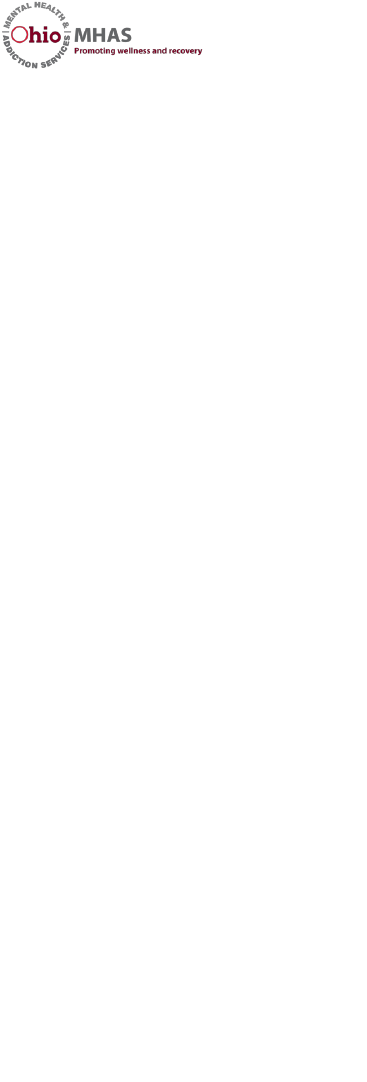
Small Business Toolkit for Adult Care Facilities Ohio Mental Health & Addiction Services Page 3 of 72
Employment Application........................................................................................... 37
Caregiver Job Description ......................................................................................... 37
Resident House Rules & Policies ............................................................................... 37
Manual Entry Bookkeeping Tool ............................................................................... 38
Resident Invoices & Payments Summary ................................................................. 38
STAFFING YOUR BUSINESS ........................................................................... 39
Hire the Right Skills ....................................................................................................... 39
Conduct a Background Check ....................................................................................... 40
Employees versus Independent Contractors ................................................................ 43
IRS form 1099-MISC .................................................................................................. 45
PAYING YOUR STAFF ...................................................................................... 46
What Is Payroll? ............................................................................................................ 46
How Much Should I Pay My Employees? ...................................................................... 47
What Are Payroll Taxes? ............................................................................................... 49
Federal payroll taxes ................................................................................................. 49
State of Ohio’s Payroll Taxes ..................................................................................... 50
IRS form W-4 ............................................................................................................. 50
Other Employer Taxes ................................................................................................... 51
Workers Compensation ............................................................................................ 53
When Do I Pay Myself? ................................................................................................. 53
Register Your Business for Required Business Taxes .................................................... 54
BUSINESS FINANCES ....................................................................................... 54
Collecting Resident Payments ....................................................................................... 54
Ohio Residential State Supplement (RSS) ..................................................................... 55
Supplemental Security Income (SSI) ............................................................................. 55
Social Security Disability Income (SSDI) ........................................................................ 56
Verifying Resident Income ............................................................................................ 56
Example of Potential Profit or Loss from Owning An Adult Care Facility ..................... 57
MARKETING YOUR BUSINESS ...................................................................... 58
Where Do I Find Clients?............................................................................................... 59
TOOLKIT SAMPLE BUSINESS FORMS .......................................................... 59

Small Business Toolkit for Adult Care Facilities Ohio Mental Health & Addiction Services Page 4 of 72
Congratulations…You’re Starting Your Own Business!
Welcome to becoming an owner of an Adult Care Facility in the state of
Ohio. The Ohio Department of Mental Health and Addiction Services
(OhioMHAS) is a great place to get started with the process of becoming
a licensed home. The primary purpose of this toolkit is to aid you in
becoming a good business owner and to get you started in the licensure
process. This toolkit should provide the necessary skills to help you
along the way.
Adult Care Facilities in Ohio range from 1-2 beds, 3-5 beds, and 6-16
beds. Owning and operating an Adult Care Facility takes time, lots of
preparation, and a commitment to serving the unique needs of your
clients.
If the primary goal is anything other than to help vulnerable people ,
then owning, operating and running
an Adult Care Facility probably isn’t
for you.
The job requires hard work, long
hours, and significant expense. So
you need to be able to find your
reward in the good you’re doing for
others. While it is impossible to list all of the operational and legal
requirements for any business, this toolkit serves as a guide for
business owners launching their venture.
Business research should be thorough and ongoing to keep up with
regulatory changes as they occur. In the sections below we provide you
with information that is helpful in planning for this new business.
ABOUT ADULT CARE FACILITIES
Let’s start by saying that getting licensed to operate an Adult Care
Facility means that you want to be a business owner. You need to
understand what is involved in starting, owning, and operating this type
of business.
Consider This…
Obtain a copy of the
Administrative Rules & Adult
Care Facility application! Visit
http://mha.ohio.gov/Default.aspx?
tabid=128

Small Business Toolkit for Adult Care Facilities Ohio Mental Health & Addiction Services Page 5 of 72
What is an Adult Care Facility?
Adult Care Facilities (ACFs) and Adult Foster Homes (AFoHs) are
residential care homes licensed by OhioMHAS for the purpose of
providing accommodations, supervision and personal care services to
unrelated adults. Residents of these facilities typically require a 24
hour level of support and assistance with daily living skills. The
population that resides in these homes consist of individuals who
without this level of support would be homeless, inappropriately
residing in nursing homes, have extended hospital stays or would be
incarcerated.
Facilities receive a two-year license to operate after complying with
the statutory requirements prescribed in the Ohio Revised Code and
the rules set forth in the Ohio Administrative Code. Homes must have
a license prior to accepting residents.
Operators must undergo a comprehensive onsite inspection of the
home in which inspectors verify the safe and sanitary condition of the
facility, the capability of the operator and staff to meet their
responsibilities in providing supervision and personal care services and
the appropriateness of the placement of each resident in the adult care
setting.
You must understand and follow the Ohio laws for owning and
operating an Adult Care Facility so that you can be sure you are
providing your new residents with the care, support, and supervision
required by law.
Learn the Adult Care Facility Terminology
Before you start your business, it is vital to understand some of the
common terminology and definitions used by those involved in Adult
Care Facility, what an Adult Care Facility is, and the basic licensure
requirements for operating an Adult Care Facility. The complete list of
definitions are cited in the Ohio Administrative Code, Chapter 5122-33-
01:
(A) “Accommodations” means housing, meal preparation, laundry,
housekeeping, transportation, social or recreational activities, maintenance,

Small Business Toolkit for Adult Care Facilities Ohio Mental Health & Addiction Services Page 6 of 72
security, and similar services that are not personal care services or skilled
nursing care.
(B) “Activities of daily living” means walking and moving, bathing, grooming,
toileting, oral hygiene, hair care, dressing, eating, and nail care.
(C) “ADAMHS board” means a board of alcohol, drug addiction, and mental
health services
(D) “Adult” means an individual eighteen years of age or older.
(E) “Adult care facility” or “ACF” as defined in section 5119.70 of the Revised
Code means an adult family home or an adult group home. For the purposes of
this chapter, any residence, facility, institution, hotel, congregate housing
project, or similar facility that provides accommodations and supervision to
three to sixteen unrelated adults, at least three of whom require personal care
services, is an adult care facility regardless of how the facility holds itself out to
the public.
(G) “Adult family home” means a residence or facility that provides
accommodations and supervision to three to five unrelated adults at least three
of whom require personal care services.
(H) “Adult group home” means a residence or facility that provides
accommodations and supervision to six to sixteen unrelated adults at least
three of whom require personal care services.
(I) “Boarder” means an adult as defined by paragraph (C) of rule 3701-20-01 of
the Administrative Code who does not receive supervision or personal care
services from the adult care facility and resides within a separate and discrete
part or unit of the adult care facility under section5119.71 of the Revised Code.
(N) “Local health department” means the board of health, or entity having the
duties of the board of health as authorized by section 3709.05 of the Revised
Code, for the health district that has jurisdiction over the location of the adult
care facility.
(O) “Manager” means the person responsible for the daily operation of an adult
care facility. The manager and the owner of a facility may be the same person.
(P) “Mental health agency” means a community mental health agency, as
defined in section 5119.22 of the Revised Code, under contract with an
ADAMHS board pursuant to division (A)(8)(a) of section 340.03 of the Revised
Code.

Small Business Toolkit for Adult Care Facilities Ohio Mental Health & Addiction Services Page 7 of 72
(Q) “Mental health board” means an alcohol, drug addiction and mental health
services board, or a community mental health board authorized by Chapter 340
of the Revised Code.
(R) “Mental health resident program participation agreement” means a written
agreement between an adult care facility and the ADAMHS board serving the
alcohol, drug addiction, and mental health service district in which the facility is
located, under which the facility is authorized to admit residents who are
receiving or are eligible for publicly funded mental health services.
(S) “Mental health services” means those services specified in section 340.09 of
the Revised Code and certified by the department of mental health in
accordance with Chapter 5122-25 of the Administrative Code.
(T) “Mental illness” means a substantial disorder of thought, mood, perception,
orientation, or memory that grossly impairs judgment, behavior, capacity to
recognize reality, or ability to meet the ordinary demands of life. “Mental
illness” does not include dementia, as defined by the most recent edition of the
“Diagnostic and Statistical Manual of Mental Disorders.”
(U) “Mental health plan for care” means the individualized plan required by
rule 5122-33-18 of the Administrative Code and entered into by the adult care
facility owner or manager, a prospective resident and the lead mental health
agency.
(W) “Owner” means the person who owns the business of and who ultimately
controls the operation of an adult care facility and to whom the manager, if
different from the owner, is responsible.
(X) “Part-time, intermittent basis” means that skilled nursing care is rendered
for less than eight hours a day or less than forty hours a week.
(Z) “Personal care services” means services including, but not limited to, the
following:
(1) Assistance with activities of daily living;
(2) Assistance with self-administration of medication, in accordance with
paragraph (C) of rule 5122-33-17 of the Administrative Code; and
(3) Preparation of special diets, other than complex therapeutic diets, for
residents pursuant to the instructions of a physician or a licensed dietitian in
accordance with paragraph (B) of rule 5122-33-20 of the Administrative Code.
“Personal care services” does not include “skilled nursing care.” A facility need
not provide more than one of the services listed in this paragraph for a facility to
be considered to be providing personal care services. Nothing in this paragraph
shall be construed to permit personal care services to be imposed upon a

Small Business Toolkit for Adult Care Facilities Ohio Mental Health & Addiction Services Page 8 of 72
resident who is capable of performing the activity in question without
assistance.
(BB) “Respite care” means temporary or periodic care provided in an adult care
facility, nursing home, residential care facility, or other type of long-term care
facility so that the usual caregiver can rest or take time off.
(CC) “Skilled nursing care” means procedures that require technical skills and
knowledge beyond those the untrained person possesses and that are
commonly employed in providing for the physical, mental, and emotional needs
of the ill or otherwise incapacitated. “Skilled nursing care” includes, but is not
limited to, the following:
(1) Irrigations, catheterizations, application of dressings, and supervision of
special diets;
(2) Objective observation of changes in the patient’s condition as a means of
analyzing and determining the nursing care required and the need for further
medical diagnosis and treatment;
(3) Special procedures contributing to rehabilitation;
(4) Administration of medication by any method ordered by a physician, such as
hypodermically, rectally, or orally, including observation of the patient after
receipt of the medication; or
(5) Carrying out other treatments prescribed by the physician that involve a
similar level of complexity and skill in administration. Nothing in this paragraph
shall be construed to permit skilled nursing care to be imposed upon an
individual who does not require skilled nursing care.
(DD) “Special dietary needs” include, but are not limited to: low or no salt
added foods; reduced fat foods; reduced cholesterol foods; reduced or no sugar
added foods; frequency and/or portion size of meals; liquid only or clear liquids
only for a period designated by a physician or dietician; and simple modification
of food textures, such as pureeing.
(EE) “Sponsor” means an adult relative, friend, or guardian of a resident of an
adult care facility who has an interest in or responsibility for the resident’s
welfare.
(FF) “Supervision” means any of the following:
(1) Observing a resident when necessary while he or she engages in activities of
daily living or other activities to ensure the resident’s health, safety, and
welfare;
(2) Reminding a resident to do or complete such an activity as by reminding him
or her to engage in personal hygiene or other self-care activity; or
(3) Assisting a resident in keeping an appointment.
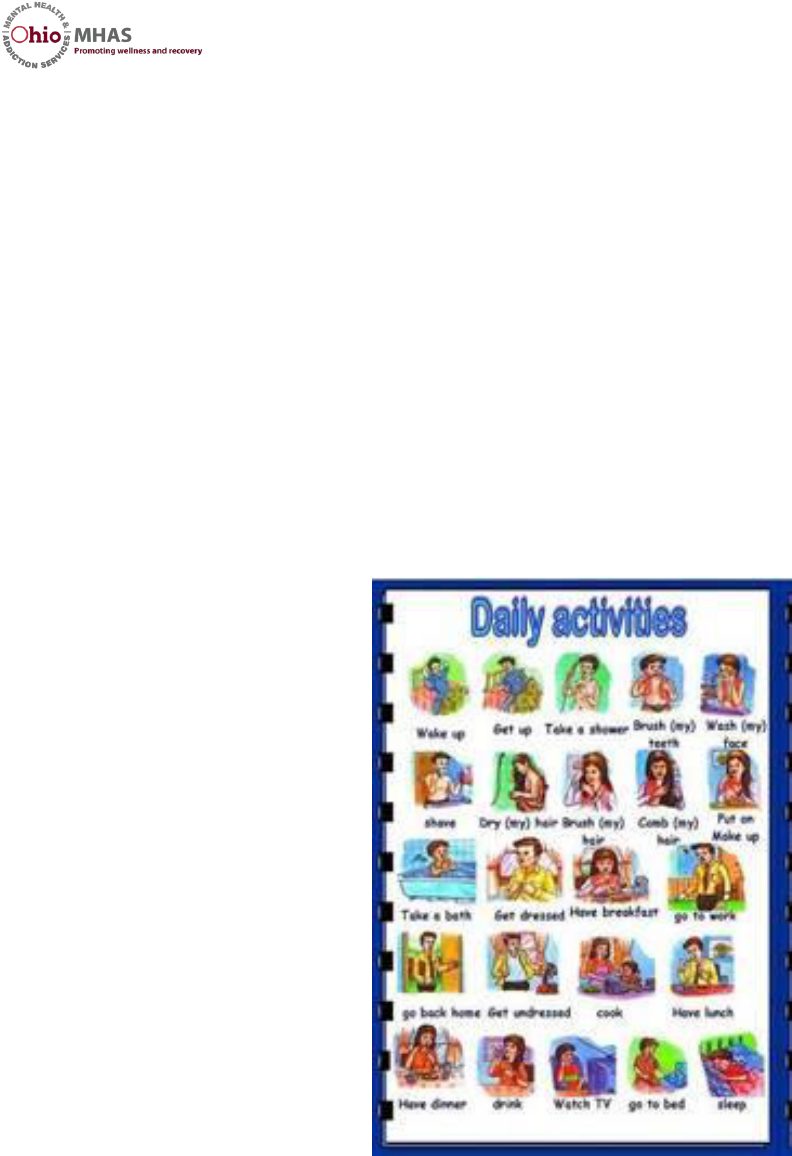
Small Business Toolkit for Adult Care Facilities Ohio Mental Health & Addiction Services Page 9 of 72
(GG) “Unrelated” means that an adult resident is not related to the owner or
manager of an adult care facility or to the owner’s or manager’s spouse as a
parent, grandparent, child, stepchild, grandchild, brother, sister, niece, nephew,
aunt or uncle, or as the child of an aunt or uncle.
Effective: 02/17/2012 R.C. 119.032 review dates: 11/30/2011 and 02/17/2017
The Assistance Required for Residents
As an owner of an Adult Care Facility, you must provide the residents
in your home with more than just a safe place to live and sleep. Here is
list of some of the things you need to do for the residents that live in
your home:
Each resident must have a bed and area for personal belongings
Home must be neat and clean
Arrange transportation
for those residents that
need to go for shopping
and errands
Prepare 3 nutritious,
well-balanced meals and
2 snacks daily, according
to the dietary needs of
each resident,
Make laundry services
available
Help with walking and
moving, bathing,
dressing, and undressing,
going to the toilet,
brushing teeth, hair care,
nail care, and eating
Provide reminders to
take medications and assistance with self-administration of
medication
Assistance with Activities of Daily Living (ADLs) and/or
Independent Activities of Daily Living (IADLs)

Small Business Toolkit for Adult Care Facilities Ohio Mental Health & Addiction Services Page 10 of 72
While you can own an Adult Care Facility and also be the manager, it is
very likely that you will need to hire others to help you provide the
level of care and supervision required by your license.
Average Business Startup Costs
The amount of money needed to start an Adult Care Facility varies
greatly depending upon many factors such as the number of beds you
decide to offer for residents, the cost of repairs that will be needed for
the home you choose, the cost for applications, the cost for obtaining
permits and zoning approvals, and the amount for essential items you
need to purchase to get started.
Here is a sample list of expenses to help get you started in thinking
about how much money you might need prior to opening your Adult
Care Facility opened:
POTENTIAL STARTUP EXPENSES
(assuming a 3 bed home)
Adult Family Home License Fee
$25-$50
Business checking account, initial deposit plus cost
of checks
$25-$75
Certificate of Use & Occupancy
$60
Zoning or Permit applications and requirements,
such as fire inspection costs, adding smoke
detectors, adding fire extinguishers
$1250-$2000
Supplies for your home (2 bed linens/resident,
blankets, pillows, towels, toiletries, cleaning
supplies)
$300-$450
Bedroom furniture for 3 new residents (bed,
nightstand, dresser)
$1200-$1800
Mortgage or rent payments (varies greatly)
$600-$900
Utilities, gas, electric, water (varies greatly)
$175-$300

Small Business Toolkit for Adult Care Facilities Ohio Mental Health & Addiction Services Page 11 of 72
Supplies for your home office (copy paper, note
pads, pens, file folders)
$25-$50
2-drawer filing cabinet
$35-$50
Initial food supply for 3 residents
$75-$100
Computer
$400-$600
Printer
$50-$75
Internet
$30-$60
Microsoft Office or Excel, if not already installed on
computer
$75-$100
Estimated total startup costs:
$4,325-$6,670*
*We are estimating economical brands and quality for the above estimates. Our mortgage or rent
estimates are average estimates. Your costs will be higher or lower based upon your personal tastes
and shopping savvy.
As you see in our example above, it could take a minimum of $4,325 to
start an Adult Care Facility business. Our example above assumes that
you won’t need any improvements to the home that you are using for
the Adult Care Facility. This does not include any costs to renovating
the residence to meet licensure standards.
Consider This…
If it takes a month or more for you to locate paying residents,
can you pay your monthly required bills?
If you don’t have the maximum number of residents
that you have capacity for in the home, can you pay
your monthly required bills?
If the home you are using as the Adult Care Facility
needs improvements in order to get licensing approval
or maintain licensing, do you have the funds to cover
the cost of improvements plus the minimum amounts
listed above for startup costs?
If you answer “NO” to any of the bulleted items list above,
then you are probably not ready to open an Adult Care
Facility.
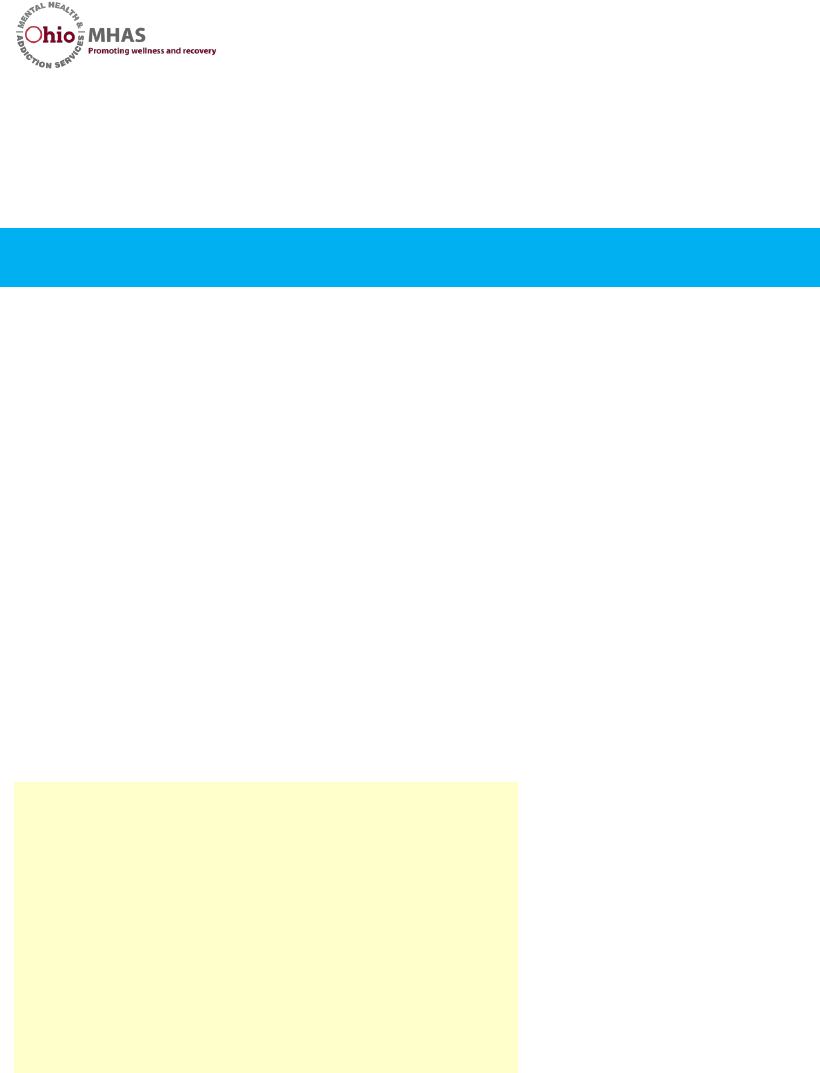
Small Business Toolkit for Adult Care Facilities Ohio Mental Health & Addiction Services Page 12 of 72
We suggest that before opening this business you make sure that you
have enough money to cover your estimated startup costs and several
months of your personal expenses.
BUSINESS PLAN DEVELOPMENT
One of your first steps in deciding to start a new Adult Care Facility
should be to develop a business plan along with a 3-year financial
projections. The business plan is a roadmap for your business growth
and success. Your business plan does not need to be a long and formal
document. It needs to include the steps required to establish and grow
your business over a specified period of time.
The financial projections help you to figure out a realistic amount of
money needed to start your business, the income you should expect,
and the related expenses. When you estimate your potential income
and potential expenses, then you can see under what circumstances
you can expect to have a profit or loss. These financial projections will
also be a good budget that you can use in operating your business each
month.
This toolkit is written
with the assumption
that you will complete a
business plan and 3-
year projections prior
to or following review
of this toolkit.
We will provide a
sample Business Plan
for your review and a blank business plan template that you can use to
develop a business plan.
Consider This…
Small Business Development Centers
located across the state of Ohio have
various types of business workshops with
staff that can assist you with developing a
business plan, including financial
projections. In many cases they offer free
assistance.

Small Business Toolkit for Adult Care Facilities Ohio Mental Health & Addiction Services Page 13 of 72
GETTING YOUR HOME LICENSED
Contact the Department of Building and Zoning Services
While the home you’ve chosen for your Adult Care Facility may seem
like the perfect location, this home may not be approved for operation
as an Adult Care Facility business. So, before you can use your home or
any other home for an Adult Care Facility, you’ll need to get
governmental approval to do so from your local Building and Zoning
Offices. Contact YOUR LOCAL Building and Zoning Services to:
1. Obtain a certificate of zoning clearance or zoning letter for the
home you want to use as an Adult Care Facility. A certificate of
zoning clearance is required prior to the construction, alteration,
or change in use of any building or structure.
2. Request a certificate of use and occupancy of the home you want
to use as an Adult Care Facility. In some counties this may be
called a certificate of use or certificate of appropriateness.
Essentially you need to obtain written confirmation that the
home you have selected can be used as an Adult Care Facility.
Your local Building and Zoning Service is responsible for enforcing state
and local building and zoning codes to help manage the safety and
quality of life of Ohio communities. You’ll need to find the office that
services the area where your Adult Care Facility will be located.
Apply for Your Adult Care Facility License
After you have obtained your building and zoning certificates, you
should apply for your Adult Care Facility license. Prior to opening an
Adult Care Facility, you must complete the licensing process through
OhioMHAS. Some states require you to obtain a business license.
Basically, a business license is a document from the government that
gives you authorization to start a business. For Adult Care Facilities,
your OhioMHAS license is your business license. When applying for your
Adult Care Facility license, you must complete a separate application

Small Business Toolkit for Adult Care Facilities Ohio Mental Health & Addiction Services Page 14 of 72
for each home that you will operate as this type of business. The
licensing process involves the following steps:
1. Submit a complete Initial Application for licensure, including the
application fee. The application fee is $25 for Adult Care
Facilities applicants of 3-5 beds and $50 for Adult Care Facility
applicants of 6-16 beds. You must submit a fully complete
application with payment included or your application will not
be reviewed.
2. The licensure department will review your application to confirm
that you have submitted all required documents.
3. The licensure department will contact you to conduct an initial
on-site inspection of the home that you propose to use for
residential care. Inspectors verify the safe and sanitary condition
of the facility.
4. The licensure department will interview the proposed facility
operator to confirm the capability of the operator and employees
to meet their responsibilities in providing supervision and
personal care services as well as the appropriateness of the
placement of each resident in the adult care setting.
5. Residential facilities that serve residents with serious mental
illness have an additional obligation to have employees and
managers oriented to the care and supervision needs of these
residents and to require specific training on an annual basis
relevant to persons with a diagnosis of mental illness residing in
the facility.
In order to be prepared for the licensure process, we recommend that
you use the OhioMHAS’ Pre-application Checklist that was created to
assist you in obtaining licensure.
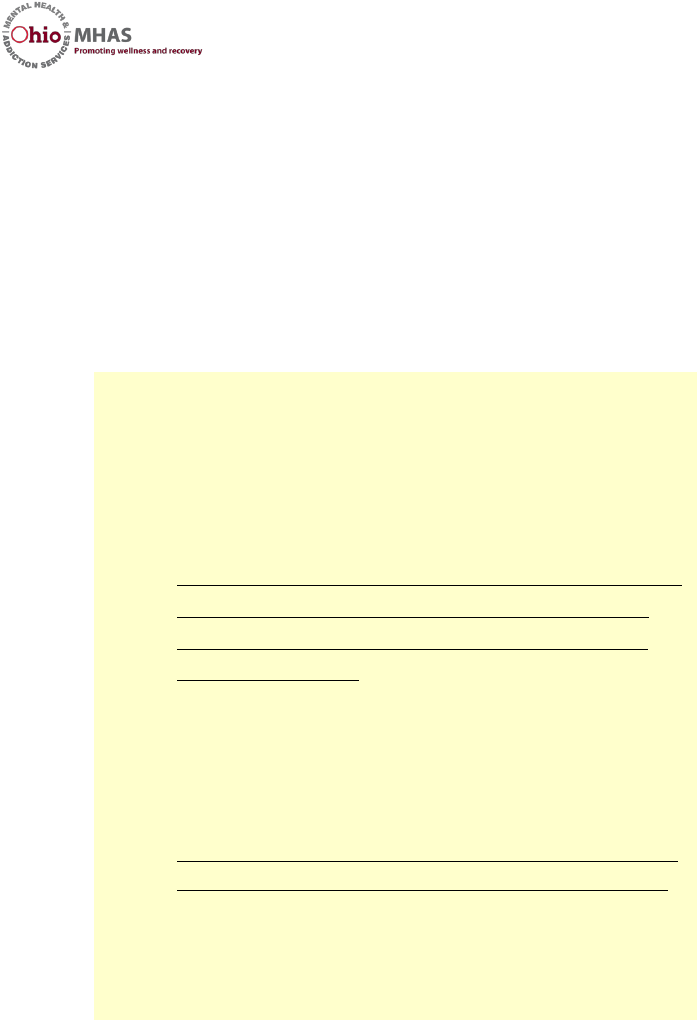
Small Business Toolkit for Adult Care Facilities Ohio Mental Health & Addiction Services Page 15 of 72
Prepare for Licensing with the OhioMHAS Pre-Application
Checklists
OhioMHAS staff have created two pre-application checklists to assist
you in preparing for the licensing process. There is a pre-application
checklist for a 3 to 5 bed home and a pre-application checklist for a 6
to 16 bed facility. We have both pre-application checklists listed below.
Consider This…
You can obtain copies of the pre-application
checklist for 3 to 5 bed homes from the OhioMHAS
website at:
http://mha.ohio.gov/Portals/0/assets/Regulation/Lice
nsureAndCertification/Residential-Facilities/Pre-
Application-Checklist-for-Adult-Family-Homes-
3to5-Residents.pdf
You can obtain copies of the pre-application
checklist for the 6 to 16 bed homes from the
OhioMHAS website at:
http://mha.ohio.gov/Portals/0/assets/Regulation/Licensur
eAndCertification/pre-application-checklist-for-agh.pdf
If you have trouble opening either website pages
above directly, then copy and paste into your browser
to open the page.
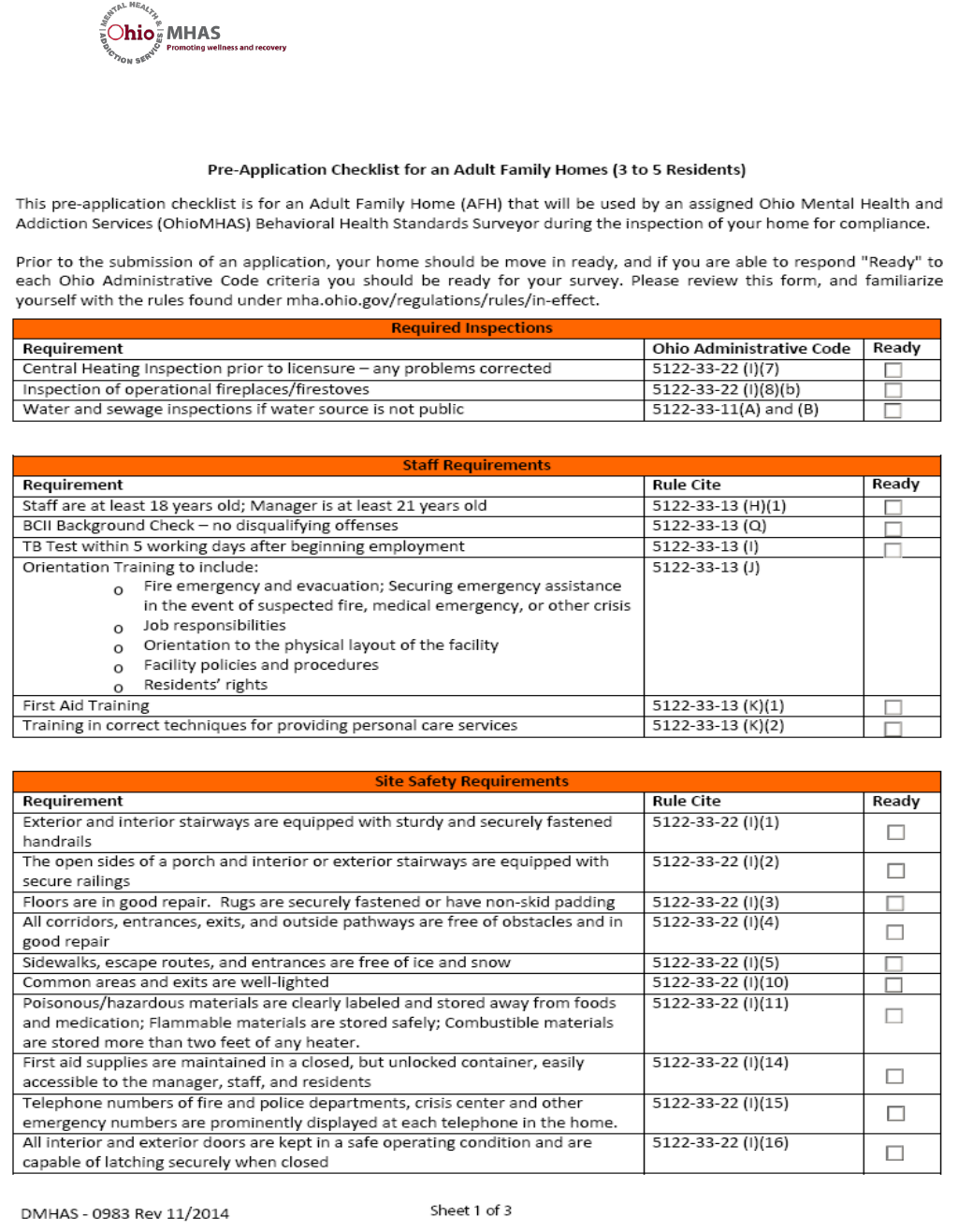
Small Business Toolkit for Adult Care Facilities Ohio Mental Health & Addiction Services Page 16 of 72
Pre-application Checklist 3 to 5 bed home
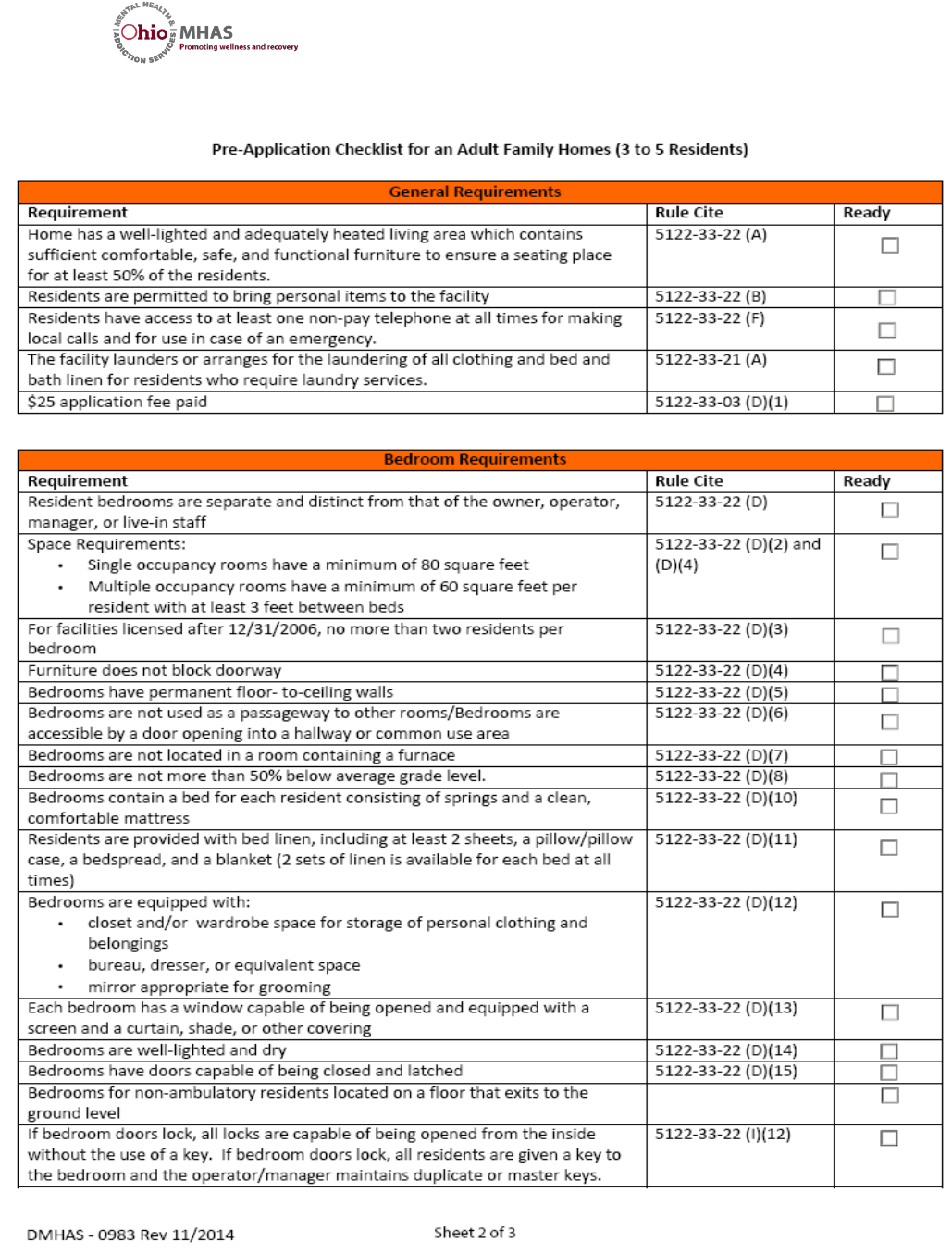
Small Business Toolkit for Adult Care Facilities Ohio Mental Health & Addiction Services Page 17 of 72
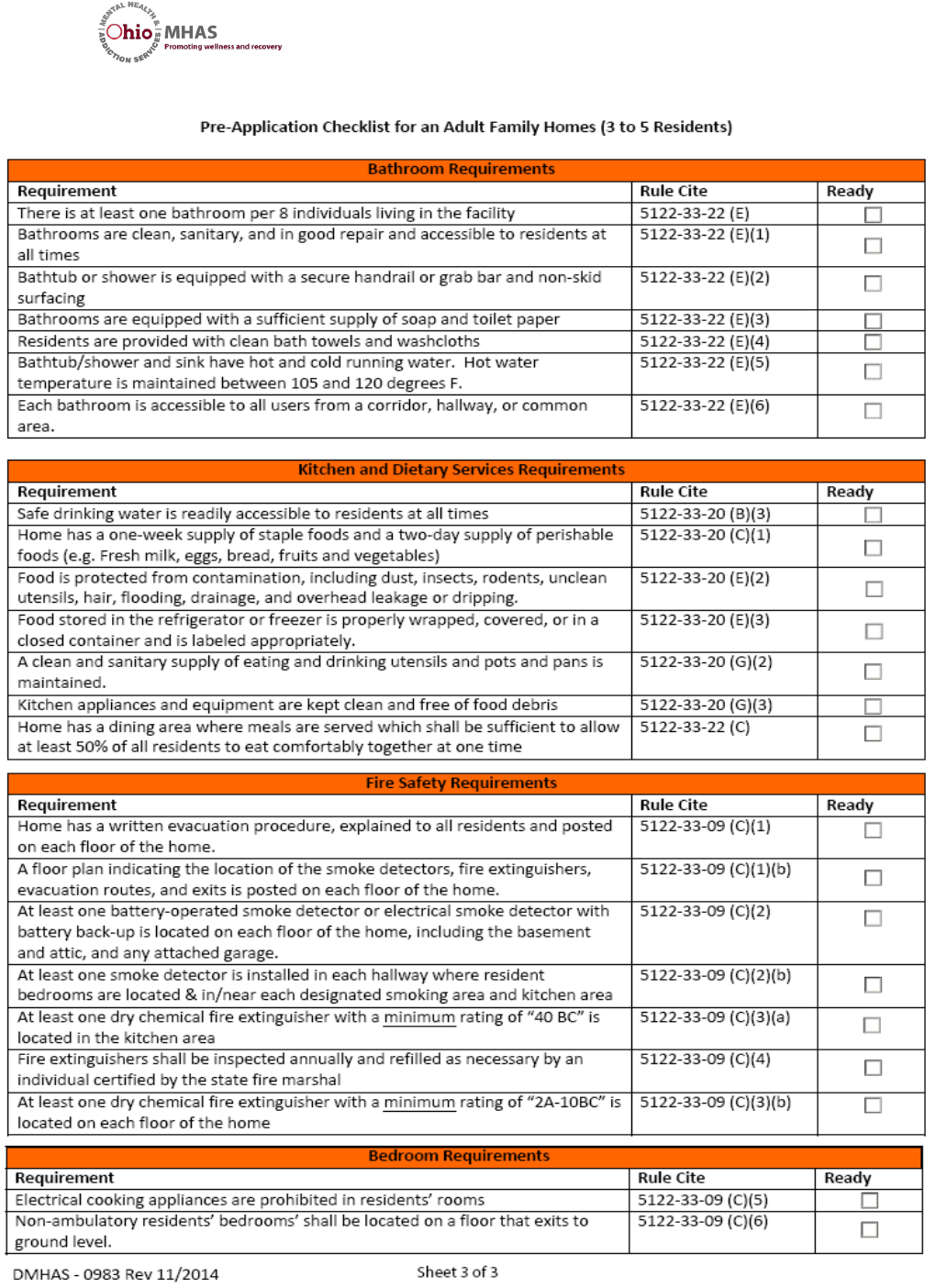
Small Business Toolkit for Adult Care Facilities Ohio Mental Health & Addiction Services Page 18 of 72
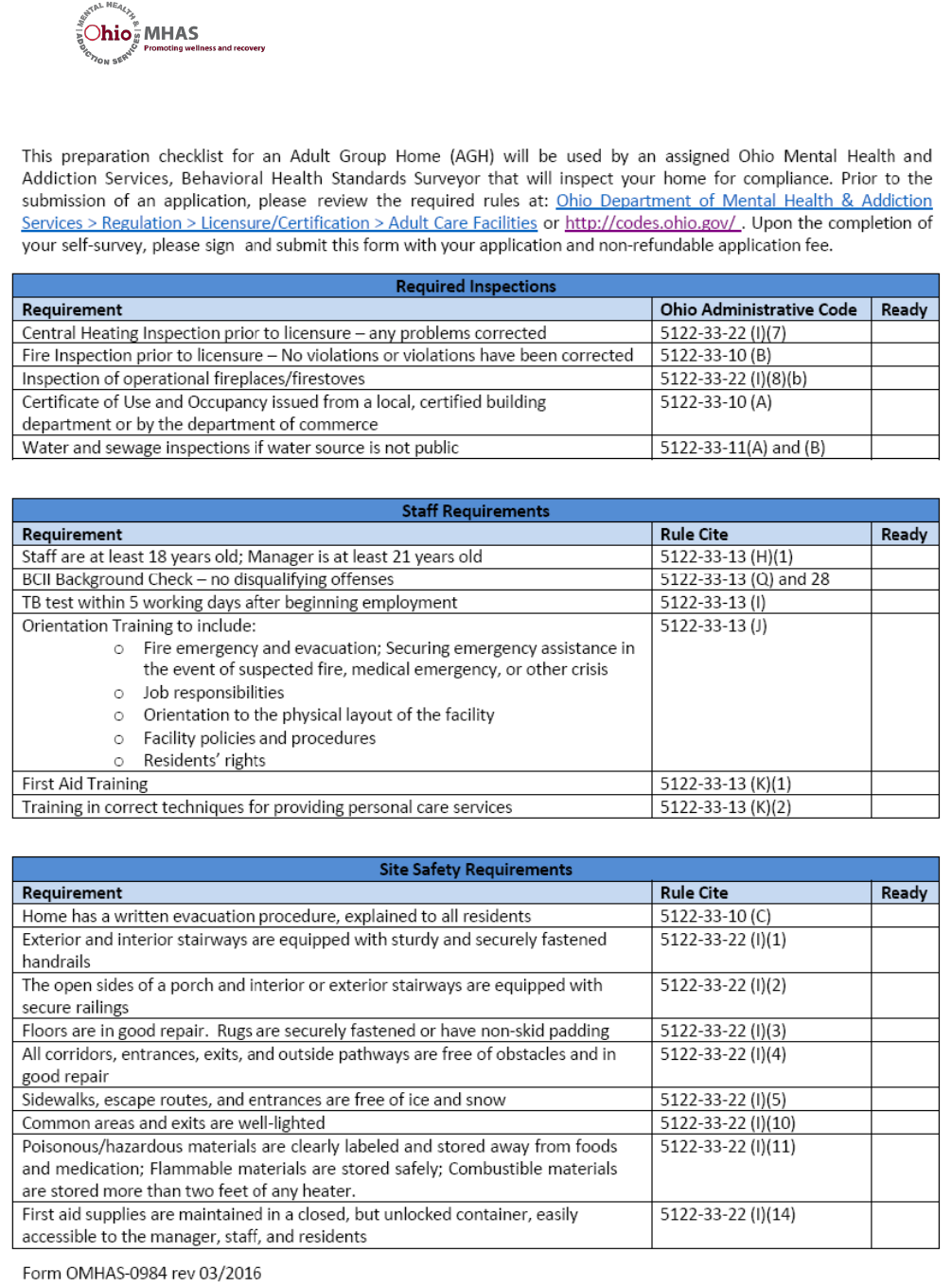
Small Business Toolkit for Adult Care Facilities Ohio Mental Health & Addiction Services Page 19 of 72
Pre-application Checklist 6 to 16 bed group home
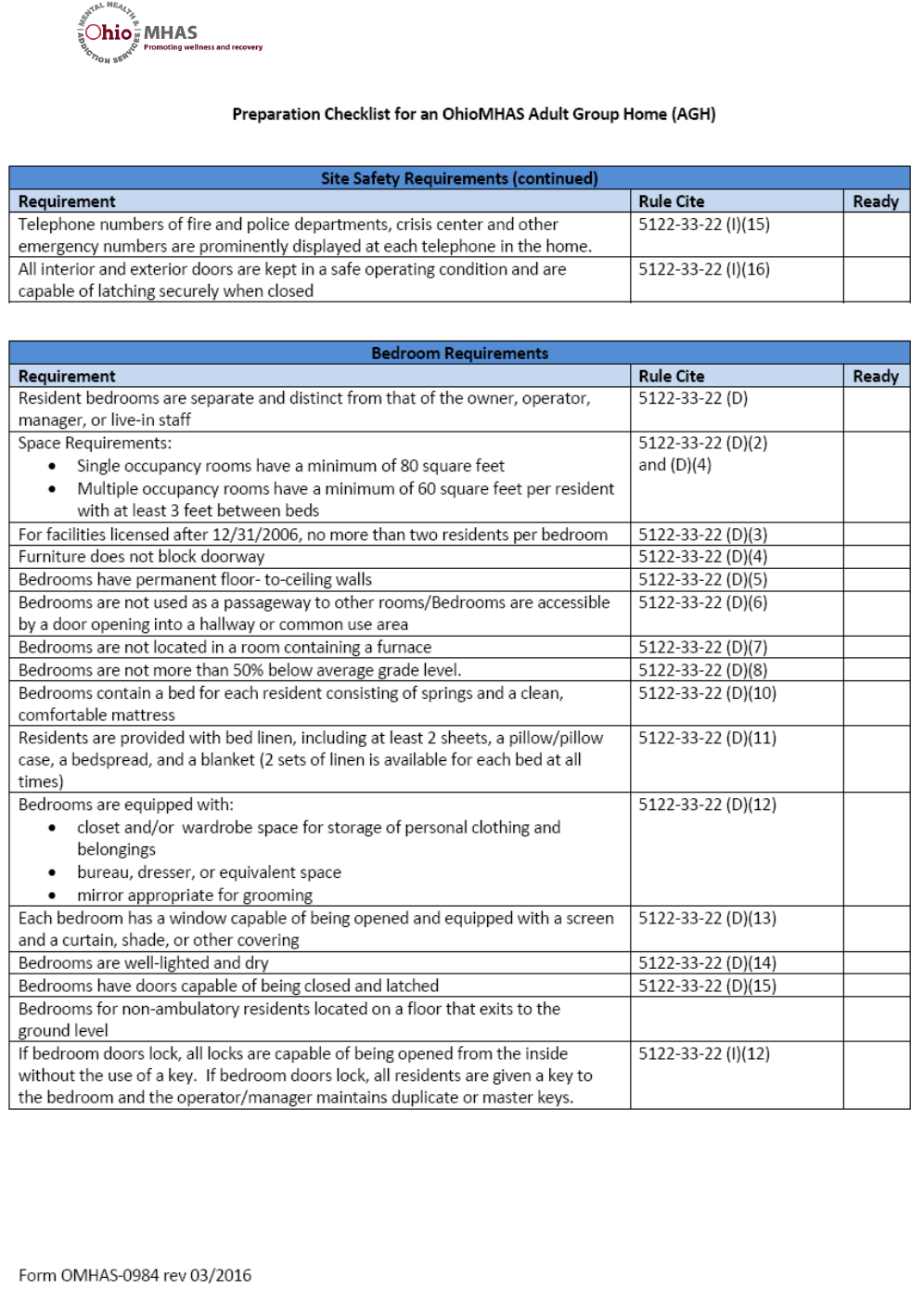
Small Business Toolkit for Adult Care Facilities Ohio Mental Health & Addiction Services Page 20 of 72
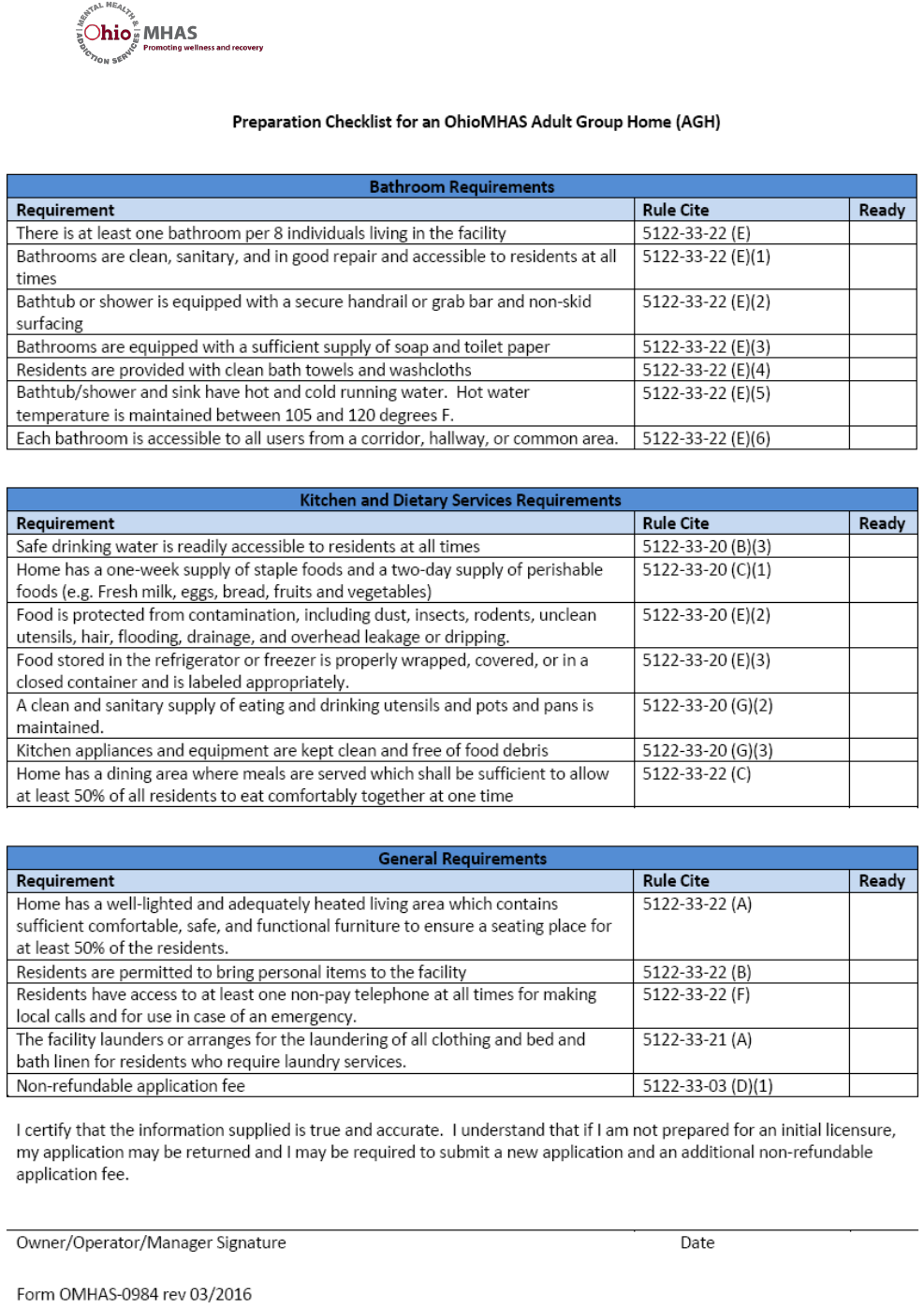
Small Business Toolkit for Adult Care Facilities Ohio Mental Health & Addiction Services Page 21 of 72
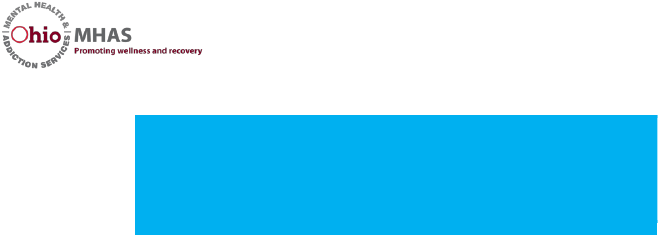
Small Business Toolkit for Adult Care Facilities Ohio Mental Health & Addiction Services Page 22 of 72
LEARN WHO TO CONTACT
WITH QUESTIONS
You are likely to have many questions about the startup, launch, and operation of
your Adult Care Facility. OhioMHAS staff can answer many of your
questions. Prior to contacting them you should understand your role
and the role of others involved in the operation and management of an
Adult Care Facility: the OhioMHAS, the Adult Care Facility Manager, and
the Adult Care Facility Owner.
OhioMHAS
The OhioMHAS is responsible for licensing Adult Care Facilities. In order
to be licensed and remain licensed, OhioMHAS must make sure that the
Adult Care Facility is operating according to the statutory requirements
of the Ohio Revised Code and the rules set forth in the Ohio
Administrative Code. OhioMHAS is also responsible for receiving and
investigating any reportable incidents that occur to residents of Adult
Care Facilities.
ACF Manager (also called Operator)
The Manager/Operator of the Adult Care Facility is the person
responsible for the daily operation. The Manager/Operator and the
Owner of a facility may be the same person. The Manager/Operator
runs the facility each day, makes sure the facility residents receive
proper care, makes sure the facility has proper staffing, and makes sure
the facility operates consistent with the law.
ACF Owner
The Owner of the Adult Care Facility can serve in the role as the
Manager/Operator. The Owner is the person who owns the Adult Care
Facility business and ultimately controls the operation of an adult care
facility. The Manager/Operator reports directly to the Owner.
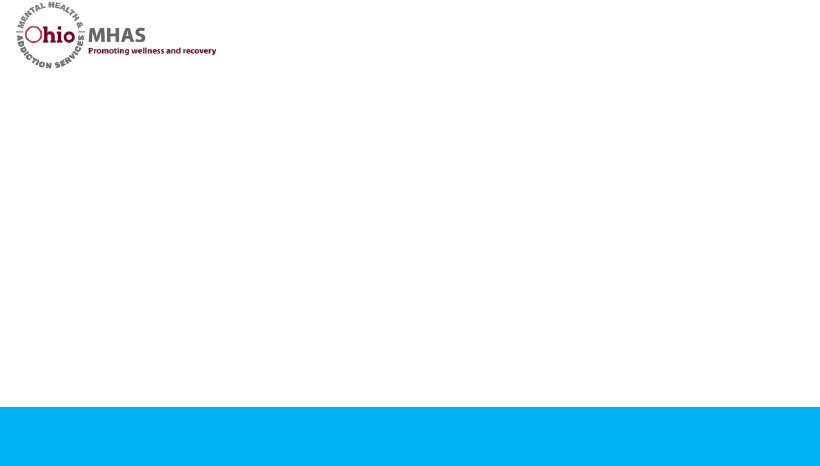
Small Business Toolkit for Adult Care Facilities Ohio Mental Health & Addiction Services Page 23 of 72
ADAMH Board
The Alcohol, Drug Addiction and Mental Health (ADAMH) Services is a
statewide county-based board to admit, treat and discharge individuals
in need of acute care and community supports. The Board is a quasi-
independent part of county government, governed by a volunteer
Board of Directors. The Board contracts with provider agencies to
deliver services that assist clients on the road to recovery.
BUSINESS STARTUP
When you have your license to open your Ohio Adult Care Facility, you
will need to follow the important next steps below in order to get your
business operational:
1. Select Your Business Name
While your business name can be whatever you want it to be,
you should select a name that is easy for customers to say, easy
to remember, and one that speaks positively to the community.
Your business name should represent the types of services that
your business will offer.
2. Determine Your Business Legal Structure
You will need to determine whether your business will be formed
legally as a Sole Proprietor, Partnership, Limited Partnership,
Limited Liability Partnership, Limited Liability Company, C-
Corporation, or S-Corporation. The legal formation of your
business has legal and tax consequences. There are advant ages
and disadvantages of each type of legal structure. You should
really do your homework to see which structure is best suited for
your needs.
Here are the business legal structure options for businesses
organized in the State of Ohio.
Sole Proprietorship

Small Business Toolkit for Adult Care Facilities Ohio Mental Health & Addiction Services Page 24 of 72
Partnership
Limited Partnership
Limited Liability Partnership
Limited Liability Company (LLC)
C-Corporation
S-Corporation
Nonprofit Corporation
In the section that follows, we give you a short description of each form
of legal structure. You should set up an appointment with a qualified
accountant or attorney to discuss these options before you finalize your
decision.
Business Legal Structure
Sole Proprietorship
The OhioMHAS is responsible for licensing Adult Care Facilities. In order
to be licensed and remain licensed, OhioMHAS must make sure that the
reportable incidents that occur to residents of Adult Care Facilities.
A sole proprietorship essentially means a person is operating business
as a sole owner. When you operate as a sole proprietorship the legal
name of the business defaults to the name of the sole business owner.
If you want your sole proprietorship business to have a different name,
then you must register your business name using an Assumed name,
Trade Name, or Fictitious Doing Business As name that is different from
your personal name.
For Example…
If Jane Doe starts an Adult Care Facility and chooses to name
her business, “Jane Doe Adult Care Facility”. This name is
considered a Doing Business As name and Jane will need to
register it with the appropriate local government agencies like
the Ohio Secretary of State.

Small Business Toolkit for Adult Care Facilities Ohio Mental Health & Addiction Services Page 25 of 72
Pros: No partnership agreements. The owner makes all decisions.
Easy to form this type of business. Federal taxes pass through to
the business owner’s personal tax return.
Cons: The business owner’s personal assets are open to attack if
the business is sued.
The legal name of your business is required on all government forms
and applications, including your application for employer tax IDs,
licenses and permits.
Partnership
A partnership is a business that is formed and operated by two or more
people. When you operate as a partnership the legal name of the
business defaults to the name of the partners. However, you can choose
to file an assumed name, trade name, or Doing Business As name. Each
partner contributes to running the business. The partners are
responsible for the actions of all partners and employees. Partners
report their share of profit or loss on their individual tax return.
The assets of the business are owned on behalf of the other partners,
and they are each personally liable, jointly and severally, for business
debts, taxes or tortious liability. For example, if a partnership defaults
on a payment to a creditor, the partners' personal assets are subject to
attachment and liquidation to pay the creditor.
Pros: The partnership business is not taxed, only the partner’s
share of profit is taxed.
Cons: Personal assets of each partner are open to attack in a
legal case.
Limited Liability Company (LLC)
A limited liability company (denoted by L.L.C. or LLC) is a legal form of
business offering limited liability to its owners. It is similar to a
corporation, and is often a more flexible form of ownership, especially
suitable for smaller companies with a limited number of owners. The
owners of the LLC are referred to as “members”. In most states a
member can be a single individual, two or more individuals,
corporations, or other LLCs. You must register an LLC with the Secretary

Small Business Toolkit for Adult Care Facilities Ohio Mental Health & Addiction Services Page 26 of 72
of State. There are several additional legal documents that must be
prepared and/or filed for this type of business.
Pros: Legal protection for the owner because business assets are
subject to any legal action. These businesses are taxed only once.
Members report their share of business income on individual tax
returns. Personal assets are generally less open to attack in a
legal case.
Cons: Usually you must have approval of all members before
management duties are transferred.
C-Corporation
C corporations (or "C corp") is a legal form of business that is owned by
its shareholders. Shareholders can be made responsible for their own
actions and actions of the business. Corporation’s owners can be an
individuals, other corporations, or other LLCs. Shareholders pay taxes
on their earnings dividends. The Corporation also pays taxes on
corporate earnings. C Corporations must register with the Secretary of
State. There are several additional legal documents that must be
prepared and/or filed for this type of business.
Pros: Legal protection for the shareholders. Easy to transfer
shares.
Cons: Double taxation because shareholder pays taxes and the
business pay taxes. Personal assets of shareholders can be
attacked but business assets are taken first. You must hold
annual shareholder meetings and record minutes from those
meetings, adoption and updates to bylaws, stock transfers and
records maintenance.
S-Corporation
An S corporation or S corp, is a C-corporation that makes a valid
election to be taxed under Subchapter S of Chapter 1 of the Internal
Revenue Code. The added benefit of S corporation status is that the
corporation does not pay federal income taxes. Shareholders pay
income taxes on their earnings.

Small Business Toolkit for Adult Care Facilities Ohio Mental Health & Addiction Services Page 27 of 72
You must register an S Corporation with the Secretary of State. There
are several additional legal documents that must be prepared and/or
filed for with this type of business.
Pros: Legal protection for the owner because business assets are
subject to any legal action.
Cons: You must hold annual shareholder meetings and record
minutes from those meetings, adoption and updates to bylaws,
stock transfers and records maintenance.
Nonprofit Corporation
In Ohio you can file a Nonprofit Corporation when your business is
focused on activities that benefit society with a goal that is not
primarily for profit. No one owns shares or interest in the property of
the nonprofit. Many ACF are structured as 501c3 Nonprofit
Corporations. IRS Publication 557 describes 501c3 and the many other
501c types of Nonprofit Corporations.
Pros: Earnings are usually exempt from taxation and the business
can receive grant money.
Cons: Income from a Nonprofit Corporation is put back into the
business whereas for profit businesses can distribute profits to
shareholders or the business owners.
Obtain Your Employer Identification Number (EIN)
The EIN is a unique nine-digit number assigned by the Internal Revenue
Service (IRS) to small businesses operating in the United States for the
purposes of identification. When obtaining an EIN, you will need to
have decided on a type of legal structure.
Most businesses need an EIN. An employer needs an EIN if it has
employees, operates a partnership or corporation and/or withholds
wages on income.
Contact the IRS to obtain an EIN. You can visit the IRS website online
at www.irs.gov to apply for an EIN on its website. The IRS uses the EIN
to identify taxpayers who are required to file various business tax
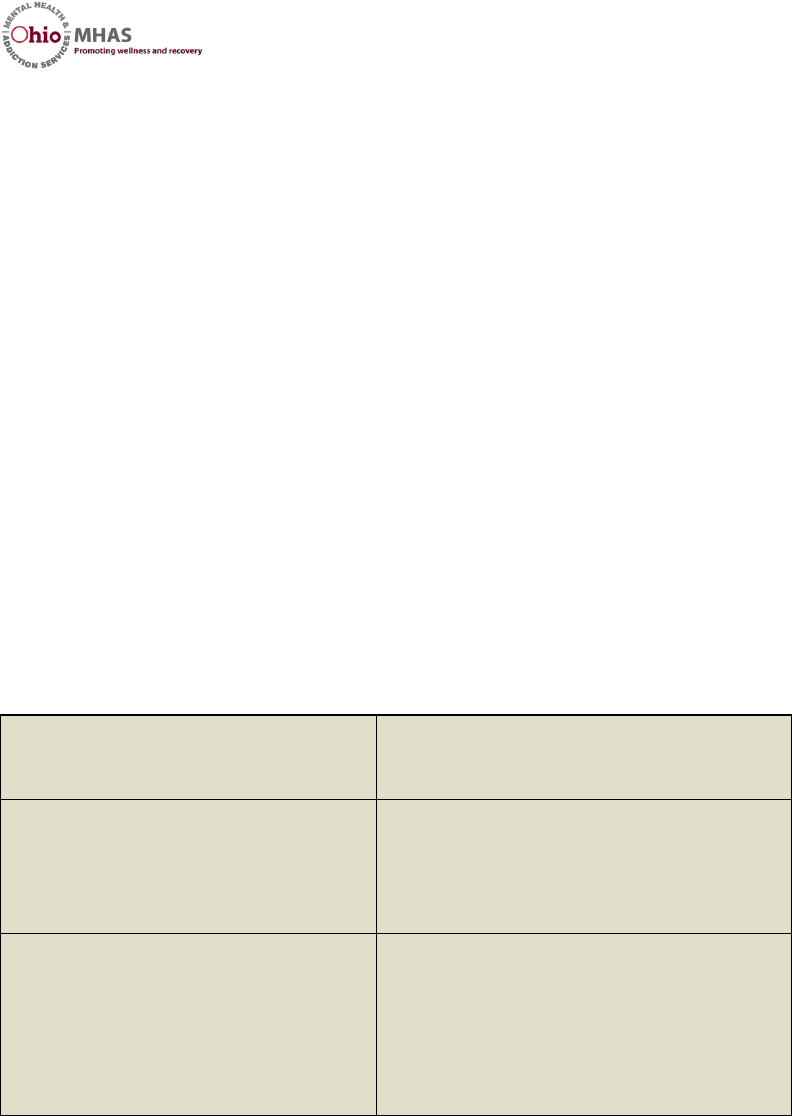
Small Business Toolkit for Adult Care Facilities Ohio Mental Health & Addiction Services Page 28 of 72
returns. Banking institutions might require an EIN for you to open a
business bank account even if you do not have employees.
Apply for Your EIN Online
Applying for an EIN number online is the easiest method for many
business owners. The application for an EIN is free. Once the
application is completed, the information is validated during the online
session, and an EIN is issued immediately. The online application
process is available for all entities whose principal business, office or
agency or legal residence (in the case of an individual) is located in the
United States or U.S. Territories. The principal officer, general partner,
grantor, owner, trustee etc. must have a valid Taxpayer Identification
Number (Social Security Number, EIN, or Individual Taxpayer
Identification Number) to use the online application.
Apply for Your EIN by Mail or Fax
Taxpayers can apply for an EIN by MAIL or FAX by sending their
completed Form SS-4 (Search IRS website) application to:
If your principal business, office or agency,
or legal residence in the case of an
individual, is located in:
Mail or Fax Form SS-4 to:
One of the 50 states or the District of
Columbia
Internal Revenue Service
Attn: EIN Operation
Cincinnati, OH 45999
Fax: (855) 641-6935
If you have no legal residence, principal
place of business, or principal office or
agency in any state:
Internal Revenue Service
Attn: EIN International Operation
Cincinnati, OH 45999
Fax: (855) 215-1627 (within the U.S.)
Fax: (304) 707-9471 (outside the U.S.)
Register Your Business Name
You are required by law to register your business with the Ohio
Secretary of State when you decide to use one of the following legal
business structures:

Small Business Toolkit for Adult Care Facilities Ohio Mental Health & Addiction Services Page 29 of 72
For-Profit Corporation
Nonprofit Corporation
Professional Association
Limited Liability Company
Partnership
Limited Partnership
Limited Liability Partnership
Sole proprietors and general partnerships operating their business
under what is called a fictitious or assumed name may also need to
apply for a “Doing Business As” certificate with the county
administrator in which the business is physically located. A fictitious
name or “Doing Business As” name is a business name which is different
from your personal name, the names of your partners, or the officially
registered name of your LLC or corporation. The contact information
for the Ohio Secretary of State is:
Ohio Secretary of State
Continental Plaza
180 E Broad St, Columbus, OH 43215
Phone: 877-767-6446
Website: www.sos.state.oh.us.
You can register your business on the Ohio Secretary of State website
or you can print the filing documents off their website and mail the
completed forms to the address listed on the forms. You can contact
the Ohio Secretary of State, Business Services division with any
questions.
Open a Business Bank Account
Keeping your personal finances separate from the operations of the
facility is good business practice. You should open a business bank
account for the income obtained from your Adult Care Facility
residents. You should use this business bank account for paying any
expenses that are related to your business such as food, rent, and
utilities for the residents. Any personal transactions, like your
automobile payment, mortgage or rent for where you live, should be
paid out of a personal bank account. This separation of funds will help
you when filing your annual business and personal income tax returns.

Small Business Toolkit for Adult Care Facilities Ohio Mental Health & Addiction Services Page 30 of 72
Obtain Adequate Insurance
As a business owner, you don’t want to wait until something horrible
happens to find out if you and your Adult Care Facility are properly
protected from a potential lawsuit. You are starting a home-based
business so it is important to confirm that you have insurance that
protects your home, auto, and business from any damages. You can
limit your liability by purchasing insurance to help protect you and your
business.
Here are some of the common types of insurance that you should
consider purchasing to protect you and your business:
Automobile Insurance
Homeowner’s insurance
General liability insurance
Worker’s compensation insurance
Automobile insurance
If you will be transporting residents of your Adult Care Facility around
in an automobile owned by you, your staff, your family, or friends, then
you might be liable for any negligence if there is an accident that results
in injuries to that resident. To protect yourself and the resident, be
sure you only transport the resident in a vehicle that is adequately
insured. It is also important that the person driving have a valid driver’s
license.
Homeowner’s insurance
You should contact the agency that insures your home and be sure you
understand the coverage that you have already in place. You should
explain that you are opening an Adult Care Facility that will have
residents paying to live in your home. Find out from your home
insurance agency specifically what your insurance covers.

Small Business Toolkit for Adult Care Facilities Ohio Mental Health & Addiction Services Page 31 of 72
For Example…
If you have a grease fire in your kitchen your
homeowner’s insurance should cover the cost to
repair resulting damages to your home.
Your insurance might require you to pay a deductible prior to the
insurance agency covering any damages.
General liability insurance
General liability insurance can protect your business from claims of
bodily injury and property damage such as if a resident or their family
claims that you provided negligent care. You should contact different
insurance companies and thoroughly explain what Adult Care Facilities
are so you can obtain a quote for coverage.
For Example…
If you have a grease fire in your kitchen and one of
your residents gets injured as a result, then this
insurance should cover the cost for your resident’s
injuries.
You need to understand specifically what the general liability insurance
will cover.
Health insurance
When you own your own business, you should consider whether you
need to purchase health insurance for yourself or offer health
insurance for your employees. Health insurance premiums for you and
your employees is considered a business expense. If you were to offer
health insurance for your employees, you can have the employee s pay
their premium or a portion of their premium.
The U.S. Department of Health and Human Services (HHS) is operating
the exchange for the Affordable Healthcare Act for small business
policies. They have created the Small Business Health Options Program
(SHOP) which is a marketplace for small employers who want to provide
health and dental insurance to their employees.

Small Business Toolkit for Adult Care Facilities Ohio Mental Health & Addiction Services Page 32 of 72
To use the SHOP Marketplace, your business must have 50 or fewer full-
time employees. You can start offering SHOP insurance to your
employees at any time of the year.
You can contact the Small Business Health Options Programs Call Center
weekdays from 9am to 7pm Easter Time at 800-706-7893 (TTY: 711).
The website address is: https://www.healthcare.gov/small-
businesses/provide-shop-coverage.
When contacting any insurance agency, you should ask questions to be
sure you understand the coverage that you are purchasing. Obtain
information on your insurance deductible and other requirements in
case you need to file a claim in the future.
Workers’ compensation insurance
Workers' compensation insurance that provides wage replacement and
medical benefits to any of your employees that are injured while
working for you. All Ohio employers with one or more employees must
have workers' compensation coverage. This is a type of insurance
required only when you have employees. This type of insurance is
discussed in greater detail in the section, Paying Your Staff.
Obtain your OhioMHAS OAKS Vendor ID Number
If the state (OMHAS or
other state agencies)
have grant or funding
opportunities to be
paid directly to the
operator, owner or facility, you must have an Ohio Administrative
Knowledge System (OAKS) vendor ID number. In order to receive the
payments from OhioMHAS. You must register with the Ohio
Administrative Knowledge System (OAKS). OAKS is the state’s
centralized system for financial management.
Consider This…
In order to receive funds from the State of Ohio,
you must have an OAKS ID number.
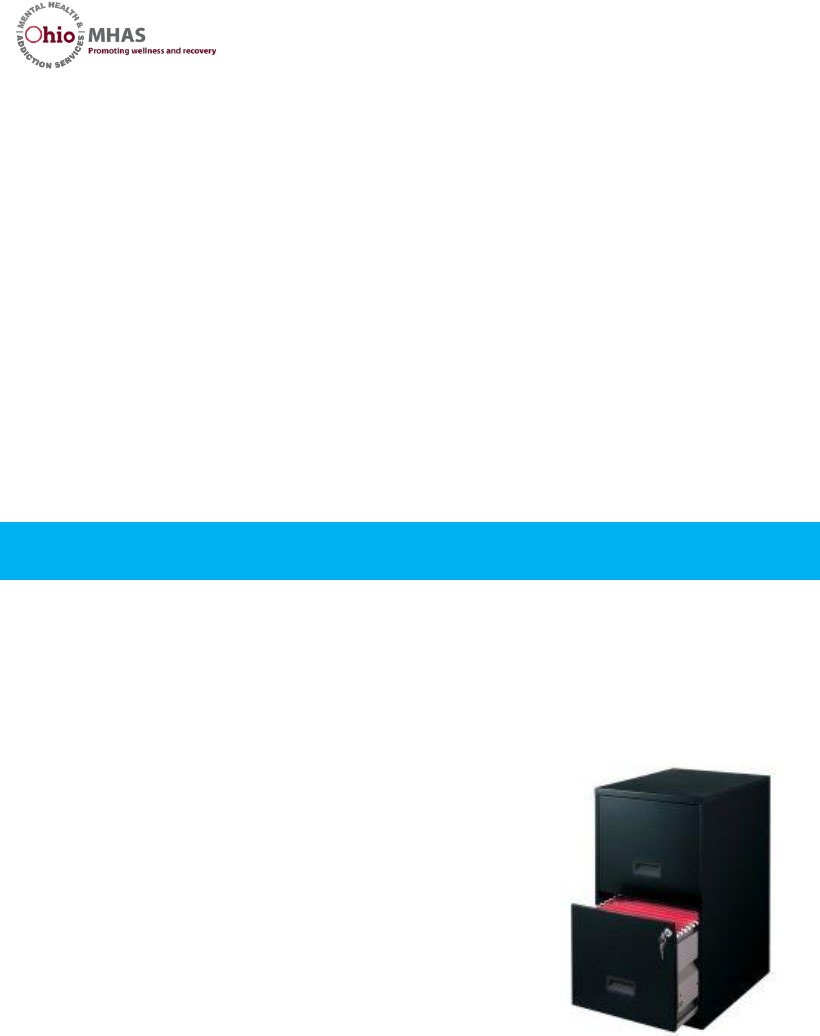
Small Business Toolkit for Adult Care Facilities Ohio Mental Health & Addiction Services Page 33 of 72
To register a new account to obtain an OAKS Supplier Number, go to
the Ohio Shared Services (OSS) Website
http://www.supplier.obm.ohio.gov/.
If you need help in completing the application, there are step -by-step
instructions to Register as a New Supplier at:
http://www.supplier.obm.ohio.gov/download/JobAid/OBM_Registerin
gNewSupplier_JA.pdf.
You may want to print these instructions before getting started. To
verify if your information has been processed or where it is in the
process, or if you have questions about completing the required forms,
please contact OSS at 1-877-644-6771 (Monday – Friday 8am-5pm EST).
ORGANIZE YOUR BUSINESS
Setup a Filing System
To get you started with organizing your business operations, you need
a good filing system. Remember to keep all of this information in a safe
and confidential place away from residents and guests. We suggest you
start by purchasing a small 2 drawer filing
cabinet that locks like this one:
Once you have purchased your filing cabinet,
here is a filing system that we think will work
well for you:
1. CREATE A RESIDENT FILES CATEGORY.
Create a file folder for each resident.
Inside each resident’s file folder include these documents:
Resident Information Form
Resident Agreement
Resident Care Plan
House Rules & Policies, signed by the resident
2. CREATE EMPLOYEE FILES CATEGORY.
Create a file folder that includes the following information for the
employee your hire to help you take care of your residents:

Small Business Toolkit for Adult Care Facilities Ohio Mental Health & Addiction Services Page 34 of 72
Completed Employment Application
3. CREATE COMPANY BLANK FORMS CATEGORY.
Create a file folder that includes copies of these documents:
Resident Information Form
Resident Agreement
House Rules & Policies
Resident Care Plan
Application for Employment
Caregiver Job Description
Invoice & Payments Summary Report
Monthly Manual Bookkeeping Tool
4. CREATE COMPANY FINANCIAL RECORDS CATEGORY.
Create a file folder that includes the financial information for your
business.
Manual Entry Bookkeeping Tool, upon completion each month
Client Invoices & Payments Summary, upon completion each
month
File for bills due to be paid
Bills paid, note the method of payment
5. CREATE REGULATORY INFORMATION CATEGORY.
Create a file folder that includes all the important regulatory
information that you need to provide training to employee s or
information that you place in binders in your Adult Care Facility or
information that you post for your residents.
You should obtain a copy of the Rules for operating an Adult Care
Facility and place a copy in a 3 ring binder to make it easily
accessible. Here is an example of regulatory information you might
include:
Copies of license

Small Business Toolkit for Adult Care Facilities Ohio Mental Health & Addiction Services Page 35 of 72
Copies of application
Required Inspections Schedule (electrical, fire, heating systems)-
Required Trainings Schedule- and copies of CEU’s for each
employee
Emergency Evacuations Policy
Patient’s Rights
HIPPA Consent Form
Certificate of Use and Occupancy
Personnel Policy
Employee Screening & Training
Policy on Providing 3 Nutritious Meals Daily
Any of the required regulatory information can be obtained from
OhioMHAS.
Keep in mind that as a licensed Adult Care Facility you are responsible
for being aware of all the legal and regulatory requirements to maintain
your license. You need to properly train yourself and your employee to
make sure you are following these regulations.
Develop Your Business Forms
When owning an Adult Care Facility, it is important to have a process
in place for smooth business operations and management. In this
section we will give you some suggestions on how to get yourself and
your business organized, including several business forms that you
should use to help operate your business efficiently. All of your
business files containing any resident information must be stored in a
locked filing cabinet.
Resident Information Form
You should capture your new resident’s information in writing and keep
it in a file folder for easy reference.
Our sample” Resident Information Form” requests the resident’s
contact information, Social Security Number, legal guardian
information, emergency contact information, and monthly income

Small Business Toolkit for Adult Care Facilities Ohio Mental Health & Addiction Services Page 36 of 72
information. You can use this form to verify the applicant’s sources of
income prior to accepting the applicant into your home.
Resident Agreement
The resident agreement is a written contract between you, the
resident, and/or the resident’s legal guardian. This document provides
specific information regarding the resident’s obligations for living in
your home and your obligations to the resident for them living in your
home. This contract should include the specific amount that you are
charging the resident each month, the due date for payments each
month, the date of any late charges or security deposits, and what
income sources will be used to make the payments each month. This
contract should also be signed by the owner or manager of the Adult
Care Facility. For complete information on information that should be
included in the Resident Agreement, refer to the Ohio Administrative
Code Chapter 3701, Rule 5122-33-16 Resident Agreement; Other
Information to Be Provided Upon Admission.
Resident Care Plan
The owner or manager should complete a Resident Care Plan. The
Resident Care Plan captures information about your residents, such as
their daily routine, daily activities, level of assistance needed,
nutritional needs, supervision needed, etc. This plan will help you be
prepared to provide the best care.
Understanding the needs of your new residents can help you confirm
that you have adequate and appropriate staff to continue providing
quality services to all your clients.
Consider This…
You need to interview each resident on an individual basis to consider
their dietary, physical, mental, and other health needs and how this
resident’s needs will mix with the needs of your existing residents.

Small Business Toolkit for Adult Care Facilities Ohio Mental Health & Addiction Services Page 37 of 72
For Example…
If you have all senior-aged residents in your home then you should strongly
consider the impact of adding a really young resident.
Employment Application
You should have each individual that you consider allowing to work for
you complete an employment application. You should also have
volunteer workers complete an employment application. Once an
employment application is completed, thoroughly review the
completed application in advance of making your hiring decision. Make
phone calls and do your research to confirm information on the
employment application. You can ask the applicant for references that
you can call and confirm their professional experience and character.
In the “Staffing Your Business” section below you will find suggestions
on the types of skills you should be seeking in an employee for your
Adult Care Facility.
Caregiver Job Description
You should have a job description for each employee position in your
Adult Care Facility. The job description will include the duties, purpose,
responsibilities of the job, the job title, and the name or designation of
the person to whom the employee reports. Use this job description
when you conduct any employee interviews.
Resident House Rules & Policies
The Resident House Rules & Policies explains important rules and
information for those accepted as residents in your home. You might
include information about how resident clients are expected to pick up
after themselves, how resident clients should respect each other’s
privacy, how resident clients should keep the noise levels respectful for
others residing in the home.

Small Business Toolkit for Adult Care Facilities Ohio Mental Health & Addiction Services Page 38 of 72
Manual Entry Bookkeeping Tool
There is a sample of this manual entry bookkeeping tool provided with
this toolkit. Instructions are included. You can use this tool to capture
the income and expenses of your Adult Care Facility. Capturing income
and expenses is really important in helping you to monitor how much
money you have coming into the business versus how much money you
have going out of the business.
You should track how much money you collect each month and the
money you spend on business related expenses. You will need to
calculate whether you have a profit or loss each month.
Resident Invoices & Payments Summary
On a monthly basis, you should keep a list of the amount of money you
invoice third-party agencies for payments for your residents. We have
included a sample form for this tracking purpose. On our sample form,
we have a place for you to record the resident’s source of income
payments to you, the amount they owe you each month, and the dates
you expect to be paid. If you are required to send an invoice or make a
payment request each month, then you need to document each month
the date you make your request. Once you receive payment each month
for each resident, you should document the date payment was
received. Keep this information in your files.
Consider This…
All your residents should have Payees because the Adult Care Facility is not
allowed to manage resident’s money.
As part of this toolkit, we have included a sample of each form listed in
the sections above. You can use them as is or make modifications as
you see needed.
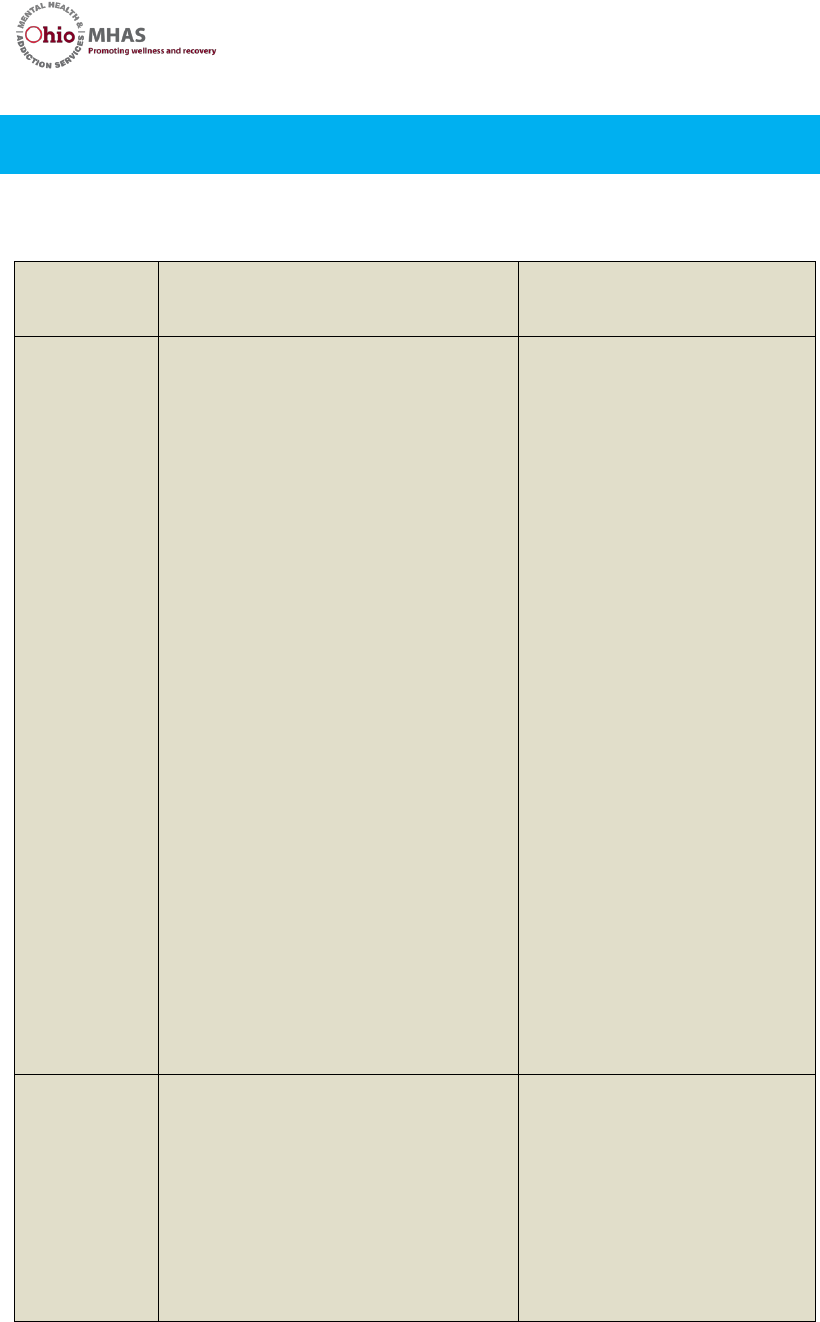
Small Business Toolkit for Adult Care Facilities Ohio Mental Health & Addiction Services Page 39 of 72
STAFFING YOUR BUSINESS
Hire the Right Skills
Adult Care
Facility Jobs
Essential Skills
Additional Skills Desired
Manager
CPR certified
Hire, train, and monitor staff
Be able to pass a background
check as required by the Ohio
Mental Health & Addiction
Services
Be able to pass a drug test
Ensure background checks
completed on any new hire
o Confirm employee has no
criminal record in
violation of OhioMHAS
rules
o Confirm employee that
transports residents has
valid driver’s license
Advocate for residents
Maintain accurate resident and
staff files
Manage invoicing and collection
of resident payments to ACF
Ability to perform all the duties
of the Resident Caretaker
Ability to assist the owner, if not
the manager, in marketing the
business for additional residents
when needed
Experience caring for
adults with developmental
disabilities
Experience caring for
adults with chronic mental
illness
Prior management
experience
Resident
Caretaker
CPR Certified
Be able to pass a background
check
Be able to pass a drug test
Provide care to residents
including but not limited to:
o Assistance with bathing,
grooming, and other
personal care
Experience caring for
adults
Experience caring for
adults with developmental
disabilities
Experience caring for
adults with chronic mental
illness
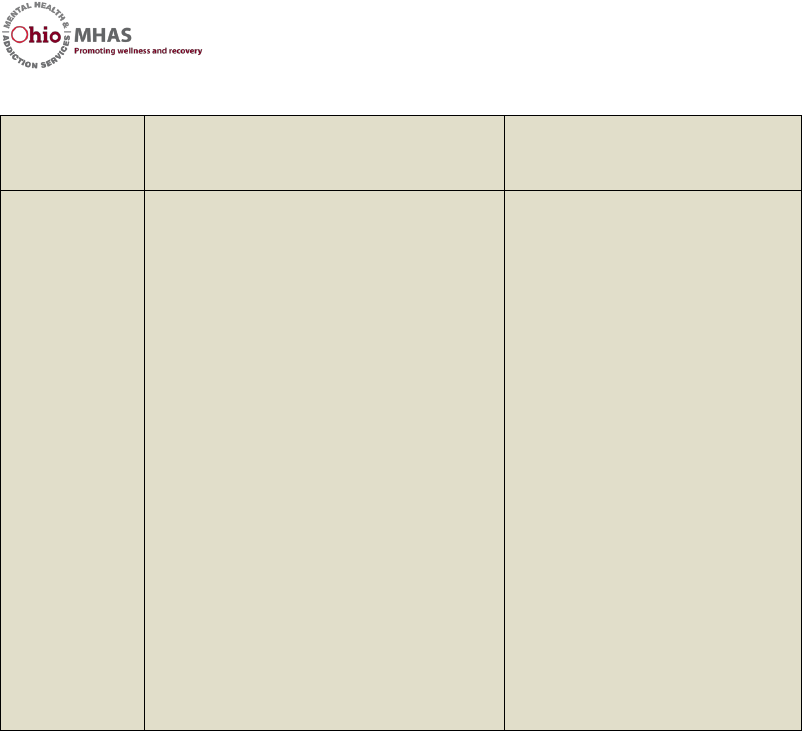
Small Business Toolkit for Adult Care Facilities Ohio Mental Health & Addiction Services Page 40 of 72
Adult Care
Facility Jobs
Essential Skills
Additional Skills Desired
o Household chores like
washing clothes, cleaning
the home, and cleaning
the dishes
o Cooking for residents
o Maintaining a safe
environment for the
residents
o Promoting dignity and
independence for the
residents
o Showing care and
compassion to residents,
their families, and other
staff
Available to work a flexible
schedule
Must have valid, active driver’s
license, if hired to drive residents
around
Conduct a Background Check
Another important aspect of owning an Adult Care Facility is protecting
your residents and protecting your business. It is a good idea to do
background checks on any individual you intend to employ in your
business with residents
When you own an Adult Care Facility, you must make sure any paid or
volunteer staff are eligible to work for you. There are certain offenses
that disqualify an individual from being an owner or staff person of an
Adult Care Facility.
Some of the permanent disqualifications include offenses like murder,
assault, and abuse crimes. The complete list of disqualifications can be
found in Ohio Administrative Code, Chapters 5122-33-12, 5122-33-13,
and 5122-33-28.
Keep in mind that any person working with your residents must meet
all the Ohio Mental Health and Addiction Services’ licensing
requirements:

Small Business Toolkit for Adult Care Facilities Ohio Mental Health & Addiction Services Page 41 of 72
Any person working in your home must be at least 18 years of
age.
Managers must be at least 21 years of age.
All staff must have first aid training.
The manager and each staff person must complete a general
orientation in caring for persons diagnosed with mental illness
as well as complete instruction on how to access local mental
health crisis and emergency services related to mental illness.
The manager must arrange for all necessary inspections,
approvals, and licenses.
The manager is responsible for hiring, and supervising staff, and
for making sure resident’s rights are protected.
Think of the residents that you take into your home as extended family.
Be sure you hire staff that you would allow to take care of your family
members.
When conducting a comprehensive background check, the screening
process gathers information from multiple sources and provides a
clearer understanding of the applicant's qualifications and reduces
your risks as a business owner.
If you are using this background check to make your hiring decision,
there are federal laws that protect the applicant from discrimination
based upon race, color, national origin, sex, or religion, disability,
sexual orientation, genetic information and age. The Equal Employment
Opportunity Commission (EEOC) enforces these laws.
Consider This…
Licensure requires that a background check is completed on each staff person
that you hire. Be sure to research the company that you use to complete your
background checks and make sure they are a reputable company.
When you run background checks through a company that provides
background information, you must comply with the Fair Credit
Reporting Act (FCRA). The Federal Trade Commission (FTC) enforces the

Small Business Toolkit for Adult Care Facilities Ohio Mental Health & Addiction Services Page 42 of 72
FCRA. Typically, the company that you hire will provide you with the
instructions to make sure you comply with these laws.
According to the Ohio Administrative Code, Chapter 5122-33-28, an
Adult Care Facility owner must contact the Ohio Bureau of Criminal
Identification and Investigation (BCI) to conduct a criminal records
check on any applicant being considered for work in the home.
Here are the locations:
BCI Main Office
1560 State Route 56 SW
P.O. Box 365
London, OH 43140
Toll-free: 1-855-BCI-OHIO (1-855-224-6446)
Phone: (740) 845-2000
Email: [email protected]
BCI Richfield Office
4055 Highlander Parkway
Richfield, OH 44286
Phone: (330) 659-4600
BCI Bowling Green Office
750 North College Drive
Bowling Green, Ohio 43402
Phone: (419) 353-5603
BCI Youngstown Office
20 W. Federal Street
Youngstown, OH 44503
Phone: (330) 884-7555
BCI Athens Office
86 Columbus Circle, Suite 202
Athens, OH 45701
Phone: (740) 249-4378
BCI Cambridge Office
1225 Woodlawn Avenue
Cambridge, OH 43725

Small Business Toolkit for Adult Care Facilities Ohio Mental Health & Addiction Services Page 43 of 72
You can use the employment application that applicants and volunteers
complete for you to contact their previous employers for references.
In order to prove someone has Cardiopulmonary Resuscitation (CPR)
Certification, you can request a copy of their CPR Certification card. If
he/she has lost his/her CPR Certification card, he/she can ask the
certifying agency for a new card. In some instances you can verify the
certification by contacting the American Heart Association:
Data Inquiry Address
American Heart Association
ECC - International
7272 Greenville Avenue
Dallas, Texas 75231-4596
Email: CPRVerify@heart.org
Employees versus Independent Contractors
An employee is a person who is hired to provide services to your
business on a regular basis in exchange for an hourly rate or salary.
Employees do not provide services as part of an independent business.
An individual working in your Adult Care Facility would be considered
an independent contractor if (s)he is paid an agreed amount of money
to take care of your residents but you are not deducting any payroll
taxes from the payments you make to this person. Unlike an employee,
an independent contractor usually works for many businesses.
Deciding whether the people that work for your Adult Care Facility are
employees or independent contractors is a very important decision.
This decision can greatly affect the amount of money you spend to
cover the cost of the staff you hire in your business.
Here are some common differences between classifying a staff person
as an Employee versus classifying a staff person as an Independent
Contractor:
EMPLOYEE
INDEPENDENT CONTRACTOR
Usually works for only one employer.
Usually works for more than one company.
Works the hours set by the employer.
Sets his or her own hours.

Small Business Toolkit for Adult Care Facilities Ohio Mental Health & Addiction Services Page 44 of 72
EMPLOYEE
INDEPENDENT CONTRACTOR
Usually works at the employer's place of
business.
Works out of his or her own office or home.
Works under the control and direction of
the employer.
Works relatively independently.
Accomplishes tasks in the manner the
employer has requested.
Has the authority to decide how to go about
accomplishing tasks, and does so without
the employer's input.
Costs associated with the job is covered
by the employer.
Costs associated with the job is covered by
the independent contractor.
Has a general education and experience
background, and receives special training
from the employer in order to do the job
better.
Has acquired very specialized skills and
comes to the work relationship with a
particularized education and experience
background.
Receives net salary after employer has
withheld income tax, Social Security and
Medicare tax under the Federal Insurance
Contributions Act (FICA).
Is not subject to tax or FICA withholding, but
pays his or her own self-employment tax.
Receives a flat rate of pay with no tax
deductions.
Eligible to receive unemployment
compensation after lay off or termination.
Is not eligible for unemployment
compensation benefits.
Eligible to receive worker's compensation
benefits for any workplace injury.
Is not eligible for worker's compensation
benefits.
Is covered by federal and state wage and
hour laws such as minimum wage and
overtime rules.
Is paid according to the terms of the
contract, and does not receive additional
compensation for overtime hours worked.
Information taken from Findlaw.com
IRS Publication Topic 762 discusses the difference between an
independent contractor and an employee. There are three tests that
determine whether your employee is a contractor or a n employee. If
the person is found to be an employee under any one test, (s)he must
be treated as an employee and the employer must withhold and pay
payroll taxes for the employee as described below.
Behavioral Control: If the employer directs or controls how the work is
done, through instructions, training, or other mean s the hired person
is a common law employee for which payroll taxes must be paid. An
independent contractor is given a task to perform, (s)he provides his
own tools and equipment, schedules his own work and performs similar
services to other employers.

Small Business Toolkit for Adult Care Facilities Ohio Mental Health & Addiction Services Page 45 of 72
Financial Control: If one or more of the following conditions applies to
the hired person, (s)he is treated as a common law employee:
The person is reimbursed for business expenses
The person does not makes his or her services available to
other businesses in the relevant market
Type of Relationship covers facts that show how the parties perceive
their relationship. The hired person is a common law employee if:
The business provides the worker with employee-type benefits,
such as insurance, a pension plan, vacation pay, or sick pay
The position is permanent and the services performed by the
worker are a key aspect of the regular business of the company
Based on our assessment, a person hired to care for clients in an Adult
Care Facility should be treated as common law employees unless they
provide similar services for other small businesses like home health
care agencies, nursing homes or other Adult Care Facilities.
However, if you choose to treat any new hire as an independent
contractor, be sure you provide them with a contract that spells out
the expectations that make him/her a contractor. Independent
contractors are responsible for paying their own income taxes and their
own self-employment tax.
IRS form 1099-MISC
When you pay an Independent Contractor $600.00 or more for working
for your Adult Care Facility, you will be responsible for preparing and
mailing that independent contractor an IRS Form 1099-MISC by January
31st of the year following the payment. The Form 1099-MISC is used to
report to the IRS and to report to the independent contractor the total
payments you made to them.
The IRS has detailed information about the distinction between an
employee and independent contractor and how to report payments
made to employees and independent contractors. You may want to
consult with your CPA, attorney, or other small business professional
on this matter before making a final decision.

Small Business Toolkit for Adult Care Facilities Ohio Mental Health & Addiction Services Page 46 of 72
PAYING YOUR STAFF
Now that you own an Adult Care Facility business you’ll need to pay
people to work for you, whether they are employees or independent
contractors. Hiring employees in your business triggers certain laws
and responsibilities of you as their employer.
What Is Payroll?
When you start an Adult Care Facility business and hire employees,
you’ll need to start processing payroll. Payroll refers to the process of
calculating and distributing your employee’s wages and deducting
payroll taxes. To calculate payroll accurately, you’ll need to learn to
make employee work schedules, track, and monitor employee’s time
worked each pay period. You will then use this information to process
payroll.
For purposes of scheduling and processing payroll you will need to
decide on what the workweek will be for your Adult Care Facility. A
workweek is a fixed and regularly recurring period of 168 hours or
seven consecutive 24-hour periods. The workweek does not have to
coincide with the calendar week. It can begin on any day of the week
and at any hour of the day. For many small businesses the workweek
begins on Sunday and ends on Saturday of each week.
How often you pay your employee is your decision. Some of the
common options are paying employees weekly, twice per month or
once per month. You’ll want to choose a payday that is the same each
month to make it easy to remember. For example, you could pay your
employee every other Friday or you could pay your employee on the
15th and last day of each month.
When setting up payroll, you may decide that you will handle the
payroll processing for yourself. There is information available to help
you.
Consider This…
There are companies that can help you with doing your
own payroll. You can do an internet search to find them.
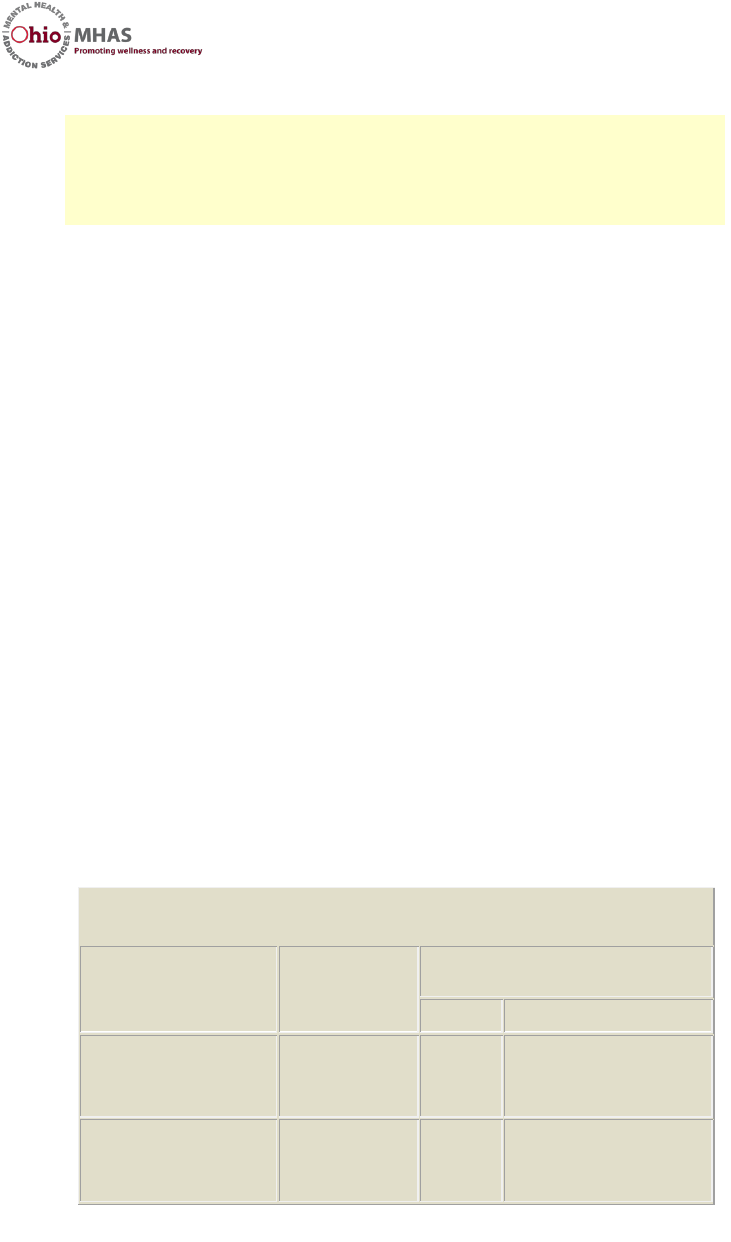
Small Business Toolkit for Adult Care Facilities Ohio Mental Health & Addiction Services Page 47 of 72
However, there are also various agencies that you can pay to process
payroll for you.
How Much Should I Pay My Employees?
As the owner of an Adult Care Facility, you must make sure you are
aware of all state and federal laws regarding paying your employee.
The primary federal law that sets the minimum wage is the U.S. Fair
Labor Standards Act (FLSA).The U.S. Department of Labor administers
and enforces the labor laws.
The state of Ohio has a minimum wage rate of $8.15 per hour. The
federal minimum wage rate is $7.25 per hour. In cases where the state
minimum wage is higher than the federal minimum wage, you must
follow your state’s laws for minimum wage pay.
In Ohio, if your business generates less than $299,000 per year you may pay your
employee the federal minimum wage rate of $7.25 per hour. If your business
generates more than $299,000 per year, then you must pay your employee the
Ohio minimum wage rate of $8.15 per hour.
Ohio Minimum Wage Rate
OHIO
Basic
Minimum
Rate(per hour)
Premium Pay
After Designated Hours
Daily
Weekly
Employers with
annual gross receipts
of $299,000 or more.
$8.15
40
Employers with
annual gross receipts
under $299,000
$7.25
40
Rate is increased annually based upon a cost of living formula.
The overtime premium rate is one and one-half times the employee's regular rate, unless otherwise specified.
You can choose to pay hourly or a salary so long as the total amount
paid divided by the total number of hours worked is equal to at least
the minimum wage.
These companies do charge you a fee for processing your
payroll so this might not be a good option for small Adult
Care Facilities.

Small Business Toolkit for Adult Care Facilities Ohio Mental Health & Addiction Services Page 48 of 72
For Example…
Let’s say you hire Sarah to work in your Adult Care
Facility for 4 days each week for 6 hours each day, at a
minimum wage rate of $7.25. You pay Sarah $174 for the
week. You calculated Sarah’s weekly wages by
multiplying 4 days by 6 hours each day = 24 hours worked
that week. You multiply 24 hours x $7.25 per hour = $174.
In the example above Sarah earned $174 in gross pay. In the sections
below you will see that you will also need to deduct payroll taxes from
this employee person’s pay.
The federal law also requires you to pay overtime pay to your
employees for time worked over 40 hours each workweek. You should
contact your local U.S. Department of Labor with any questions:
Cincinnati Area Office
US Dept. of Labor
Wage & Hour Division
550 Main Street
Room 10-409
Cincinnati, OH 45202-5208
Phone: (513) 684-2908
1-866-4-USWAGE
(1-866-487-9243)
Cleveland Area Office
US Dept. of Labor
Wage & Hour Division
Federal Office Building
1240 E. 9th Street, Room 817
Cleveland, OH 44199-2054
Phone: (216) 357-5400
1-866-4-USWAGE
(1-866-487-9243)
Columbus District Office
US Dept. of Labor

Small Business Toolkit for Adult Care Facilities Ohio Mental Health & Addiction Services Page 49 of 72
Wage & Hour Division
200 North High Street, Room 646
Columbus, OH 43215-2408
Phone: (614) 469-5678
1-866-4-USWAGE
(1-866-487-9243)
When you have employees you are required to deduct various employment taxes
from their pay each time you pay them.
Please see the section below for more information on what types of taxes you
would need to pay, how you calculate these taxes, and where you send these tax
deductions you subtract them from your employee’s checks.
What Are Payroll Taxes?
When you have employees, you are required by law to pay state and federal
payroll taxes. These taxes are also called employment taxes. When you have
employees, you might also be required to purchase workers compensation
insurance and unemployment insurance.
Federal payroll taxes
The two main federal payroll taxes deducted from employee’s wages are known
as Federal Insurance Contributions Act (FICA) taxes. Employees and employers
both pay FICA taxes: employees usually have them withheld from their paychecks,
while employers pay them in addition to any other taxes they owe. These two
FICA taxes are paid at a total of 15.3% of gross employee wages:
Social Security tax, is deducted at a rate of 12.4 percent (split evenly
between employees and employers) up to a maximum amount of an
employee’s wages ($118,500 in calendar year 2016). This wage cap is
adjusted annually to take account of increases in average wages. The
revenues go toward funding Social Security, which pays benefits to
retirees, persons with disabilities, and survivors of deceased workers.
Medicare tax is deducted at a rate of 2.9 percent of wages (split evenly
between employees and employers); unlike the Social Security tax, there
is no wage cap. Married filers’ earnings over $250,000 (and singles’
earnings over $200,000) are taxed at an additional 0.9 percent, for a total

Small Business Toolkit for Adult Care Facilities Ohio Mental Health & Addiction Services Page 50 of 72
of 3.8 percent on this income. Revenues from the Medicare tax support
the hospital insurance portion of Medicare.
People who work for themselves pay a self-employment tax called the Self
Employment Contributions Act (SECA) tax that also funds Social Security and
Medicare. These taxes are equivalent to FICA taxes with the same basic rates and
caps as paid by employees.
A third federal payroll tax is the Federal Unemployment Tax Act (FUTA)
tax. Employers pay an effective rate of 0.6 percent on the first $7,000 of a
worker’s wages. The revenues mainly go toward financing the administration of
state unemployment insurance programs. Each state collects an additional
unemployment payroll tax to further finance unemployment benefits
State of Ohio’s Payroll Taxes
Ohio State Income Tax is very similar to federal payroll taxes. Ohio collects taxes
based on income “brackets.” The higher a taxpayer's income, the higher rate s/he
pays in taxes. For 2016, these rates vary from 0.495% of taxable income, up
to 4.997%.
The state of Ohio’s Employee Withholding Certificate Form IT4 must be completed
and has very similar information as the federal W-4 employee withholding form.
The Ohio Department of Taxation provides the blank IT4 forms and the tax tables
that are used for calculation of employee payroll tax deductions. The employee is
to complete this form and turn it back in to you. The instructions on how to
complete the form included with each form. This form should be kept in each
employee’s file.
IRS form W-4
As the business owner, you will have your employees complete the W-4 form
when they are hired. This form is used to calculate the correct amount of income
tax to be deducted from your employee’s personal payroll check.
For more information on the W-2 form, contact the IRS. This form may change
from year to year, and the employer is responsible to know about the changes.
You can download and print the W-4 form from the IRS website at www.irs.gov.

Small Business Toolkit for Adult Care Facilities Ohio Mental Health & Addiction Services Page 51 of 72
All new employees must fill out a W-4 form. If his/her marital status or number
of dependents changes, (s)he complete a new W-4 form. It is best to check with
your employee every year for any changes.
I-9 Form, Employment Eligibility Verification
Employers must complete and retain an I-9 Form for each employee,
including non-citizens. The employer must examine the employment
eligibility and identity document(s) an employee presents to determine
whether the document(s) reasonably appear to be genuine and relate
to the individual and record the document information on the Form I -
9. The list of acceptable documents can be found on the last page of
the form. This form can be found at www.uscis.gov.
Other Employer Taxes
Federal Unemployment Tax Act (FUTA)
Federal Unemployment Tax Act (FUTA) regulates state unemployment
insurance systems. Currently, the tax rate is 6.2% and is applied to the
first $7,000 in wages paid to each employee during the year. Most
Adult Care Facilities will pay a tax rate of 0.8%. FUTA tax deposits can
be made quarterly and reported annually by using IRS Form 940 or 940-
EZ.
State Unemployment Insurance Taxes
When you pay unemployment insurance taxes, the money is used to pay
any employees that lose their job through no fault of their own , such
as if the employee is laid off, the job was discontinued, or the business
closed.
When an employee is laid off for “just cause,” the employee may be
found to be ineligible for unemployment benefits. Ohio law says that
just cause is whether the action taken would be taken by an ordinary
careful person under similar circumstances. Examples of just for an
employer terminating an employee are as follows:
Violated established company rules
Neglected your job responsibilities

Small Business Toolkit for Adult Care Facilities Ohio Mental Health & Addiction Services Page 52 of 72
Disregarded the employer's interest
Performed their work poorly
The Division of Tax and Employer Service will make the determination
as to whether an employee is terminated for just cause. This a gency
administers the tax and wage record provisions of the Ohio
Unemployment Compensation Law.
Most employers are liable to pay unemployment compensation taxes
and report wages paid to their employees on a quarterly basis.
Highlighted below are two important pieces of information to help you
register your business and begin reporting. To register your account by
paper, please complete a Report to Determine Liability (JFS-20100) and
mail it to:
Ohio Department of Jobs & Family Services
Office of Unemployment Insurance Operations
30 E. Broad Street 32nd Floor
Columbus Ohio 43215
Telephone: 614-466-2319
Email: unemployment.ohio.gov
In most situations, you are required to pay unemployment insurance
taxes under the Ohio unemployment compensation law if you meet
either of the following requirements:
You have at least one employee in covered employment for some
portion of a day in each of 20 different weeks within either the
current or the preceding calendar year; or
You paid wages of $1500 or more to employees in covered
employment in any calendar quarter within either the current or
the preceding calendar year.
There can be some exceptions. To learn more about these exceptions,
contact the Ohio Department of Jobs & Family Services, Office of
Unemployment Insurance Operations at the telephone/email address
listed above.

Small Business Toolkit for Adult Care Facilities Ohio Mental Health & Addiction Services Page 53 of 72
Workers Compensation
Workers Compensation insurance provides wage replacement and
medical benefits to employees injured in the course of employment.
The Ohio Bureau of Workers Compensation (BWC) manages the Ohio’s
Workers Compensation insurance program. You must contact BWC to
determine what amounts, if any, you are required to pay:
Ohio Bureau of Workers Compensation
30 W. Spring Street
Columbus, OH 43215
Phone: 800-644-6292
Website: www.bwc.ohio.gov
The average rate to employers for Ohio workers compensation
coverage is $1.07 per $100 of payroll, for policy year beginning July 1,
2016.
When Do I Pay Myself?
Many Adult Care Facilities are managed by the owners. These owners
often work in the business. As an owner of the business, you decide if
you will be paid in the same fashion as for those that work for you are
paid. Typically, owners of small businesses pay themselves after all of
their workers have been paid and after all of their business expenses
have been paid.
An owner should take a salary only when the business has a profit for
the month. Sometimes this is called an owner’s draws. Owners will use
the money for personal use. Owner draws from the business might
include cash withdrawals, ATM transactions, debit cards, or cash for
personal non-business purposes (paying a mortgage, car note,
groceries, family vacations, dinners, etc.) When an owner takes money
out of the business for personal use the amounts must be documented
just as you document the income and business expenses.
You can decide to pay yourself as an employee of your business. In this
case you would receive a paycheck from your business on a regular
basis. You will likely need to make the decision on when you pay

Small Business Toolkit for Adult Care Facilities Ohio Mental Health & Addiction Services Page 54 of 72
yourself based upon how well you manage the money you generate
you’re your Adult Care Facility.
The best way to guarantee regular payments to yourself is learning to
properly manage your business finances.
Register Your Business for Required Business Taxes
If you have employees, all employment tax payments will need to be
paid to the Ohio Department of Taxation. The Ohio Department of
Taxation provides the collection and administration of federal, state
and local business taxes. This department is responsible for collection
of your employer withholding, unemployment compensation, and
workers’ compensation payments:
Ohio Department of Taxation
4485 Northland Ridge Blvd.
Columbus, OH 43229
Phone: 888-405-4039
Website: http://www.tax.ohio.gov
You’ll need to contact the Ohio Department of Taxation to setup your
business account to begin making payments. The Ohio Department of
Taxation has setup an Ohio Business Gateway which is an online shop
to make it easy for business tax filing. You can find this Ohio Business
Gateway from their website listed above.
BUSINESS FINANCES
When running a business, it is important to keep your finances in order.
Because your business is home-based, it is easy to mix business and
personal expenses. Business finances should be kept separate from
personal finances. This separation helps keep business affairs easy to
understand by you or the IRS, should you be audited. This separation
is also why it is important to maintain a business bank account.
Collecting Resident Payments
The residents of the Adult Care Facility are responsible for making
payments to live at the facility. In many cases, the resident is receiving

Small Business Toolkit for Adult Care Facilities Ohio Mental Health & Addiction Services Page 55 of 72
some sort of governmental financial assistance that can be used to ward
their rent payments to the Adult Care Facility.
These are the most common types of income your residents will
receive:
Supplemental Security Income (SSI)
Social Security Disability Income (SSDI)
Ohio Residential State Supplement (RSS)
Other types of assistance may come from the following sources:
Department of Developmental Disabilities
Alcohol Drug Addiction and Mental Health Board
Veterans Administration
Family Members
Your residents would use these payments along with their other
personal income to pay the monthly allowable rent amount to you.
Ohio Residential State Supplement (RSS)
RSS is an optional state supplementation program for Ohio that
provides financial assistance to Medicaid-eligible aged, blind, and
disabled adults who have increased needs due to a disability that is not
severe enough to require long-term care in a facility. RSS funds can be
used to supplement monthly costs for residents of Adult Care Facilities.
The OhioMHAS administers the RSS Program and reviews all new
applications. Once the RSS administrator has reviewed the forms, the
applicant’s information is forwarded to his or her local County
Department of Job and Family Services (CDJFS) office for a financial
eligibility determination. When the CDJFS office determines that the
applicant’s income is within limits, the applicant is enrolled in t he RSS
Program or placed on the RSS wait list.
Supplemental Security Income (SSI)
Supplemental Security Income (SSI) is a federal program through the
Social Security Administration that helps people who have disabilities,
are blind, or are over age 65 and also have low income and
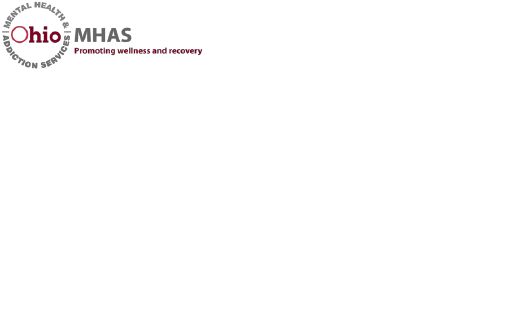
Small Business Toolkit for Adult Care Facilities Ohio Mental Health & Addiction Services Page 56 of 72
limited resources. The Social Security Administration (SSA) runs the
program. If you qualify for SSI, you get monthly cash payments to help
you pay for your basic needs and automatically qualify for Medicaid
health coverage.
Social Security Disability Income (SSDI)
Social Security Disability Income (SSDI) is a federal program through
the Social Security Administration that gives money each month to
people who have a disability that meets Social Security disability
rules and who, in the past, worked and paid FICA taxes for enough time
to qualify. SSDI has no income limits and no resource limits. The
amount you get in SSDI benefits depends on your Social Security
earnings record. After getting SSDI benefits for two years, you
automatically qualify for Medicare health coverage.
SSDI also offers benefits to family members, including child ren and
widows, when a primary wage earner in the family becomes disabled or
dies. Additionally, adults whose disabilities began before they turned
22 may be able to get Childhood Disability Benefits (CDB).
Verifying Resident Income
Some people may qualify for multiple income sources at the same time.
Here’s how you verify an applicant’s Supplemental Security Income:
You can have the resident sign a Consent for Release of
Information that authorizes your Adult Care Facility to obtain
verification of their RSS, SSI, or SSDI payment amounts.
You can also ask the resident to request a Benefit Verification
Letter, sometimes called a Proof of Income Letter, or Proof of
Award Letter. This is an official letter from the Social Security
Administration that you can use to obtain proof of income. The
resident or his or her legal guardian can call the Social Security
Administration or log into their account on the internet to make
the request. They can call the SSA at: 800-772-1213, Monday
through Friday from 7 a.m. to 7 p.m.
Those individuals that do not receive any governmental income will be
considered your private pay clients. You can offer accommodations to
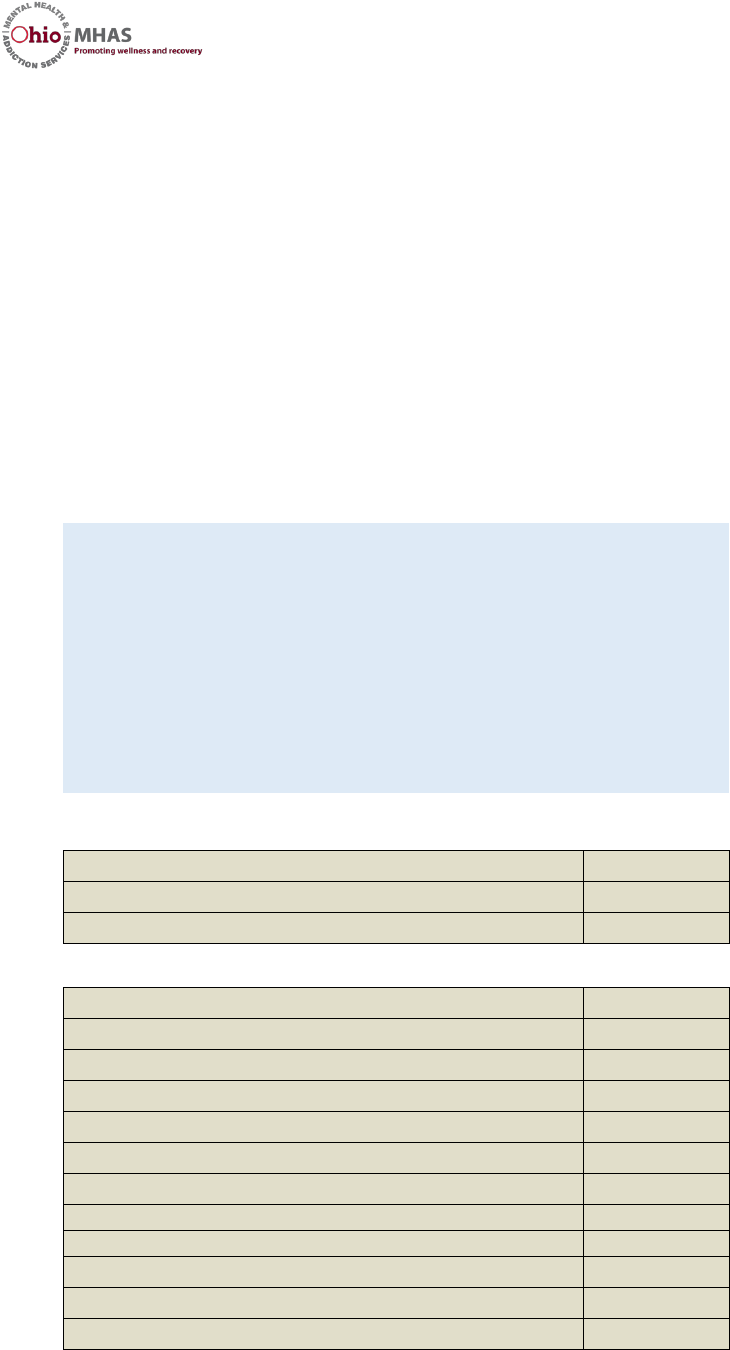
Small Business Toolkit for Adult Care Facilities Ohio Mental Health & Addiction Services Page 57 of 72
private pay families so long as they can afford to pay the amount you
are charging. You should make sure it is based upon a rate similar to
other businesses that provide similar services as your business.
Example of Potential Profit or Loss from Owning An Adult
Care Facility
When obtaining licensing for an Adult Care Facility, you are licensed for
a home with 3 to 5 beds. In other words, you can serve 3 to 5 residents.
Keep in mind that when you start your business you might not have the
number of residents that you are licensed to serve. It is possible that
you will not maintain full capacity of clients each month.
For Example…
You have a licensed Adult Care Facility.
You have 3 residents each receiving RSS monthly income
of $1,100.00.
You are the owner living in the home as the manager.
You are paying monthly rent of $750.
Your monthly expenses total $1,880.
See the resulting Profit & Loss Statement below.
Here is a sample of potential monthly profit and loss:
GROSS INCOME
$
RSS Income* ($1100 each x 3 residents)
$3300
TOTAL INCOME
$3300
MONTHLY EXPENSES
Bank Account Monthly Fee
$10
Cable
$20
Electric/Gas/Water
$375
Internet
$20
Minor repairs
$50
Resident Food
1
(@ $75 per resident)
$225
Rent
$750
Employee
2
(40 hours per week * $7.25 per hour x 4 weeks)
$1,160
Telephone (landline)
$10
Water
$10
Owner’s Draws
3
(see section “When Do I Pay Myself” for further info)
$0
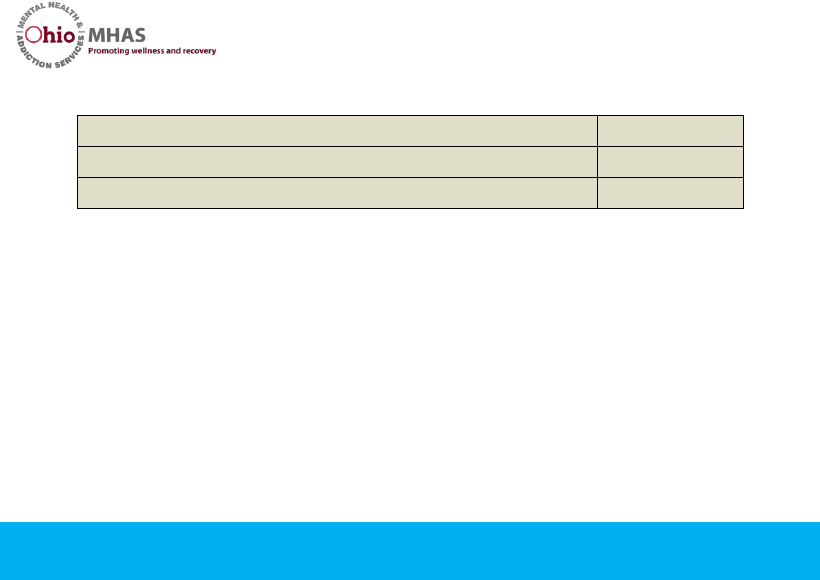
Small Business Toolkit for Adult Care Facilities Ohio Mental Health & Addiction Services Page 58 of 72
TOTAL MONTHLY EXPENSES
4
$2630
NET PROFIT (OR LOSS)
$670
1
We are assuming RSS payments of $1,100 per month.
2
We are assuming that the owner is working in the home for at least 16 hours of each day. This
means the owner must pay someone to work 8 hours each day for an average of 30 days.
3
Owner’s draws is money the owner takes out of the business to use for non-business reasons.
4
These expense estimates exclude startup expenses, payroll taxes, and insurance costs.
Based on this example Profit & Loss Statement, you can see the
importance of creating a monthly budget for your Adult Care Facility in
order to make sure you properly track the money coming in and going
out of your business.
MARKETING YOUR BUSINESS
Adult Care Facility owners and managers are responsible for getting
their clients. There are no referrals from the state of Ohio. You need to
create a marketing strategy of how you will make the community aware
of your new Adult Care Facility business. Marketing your business is
about building relationships and trust with both referral sources and
families.
You should create a brochure or flyer that describes your Adult Care
Facility, the services you provide, and any other information that makes
your business unique from other Adult Care Facilities. You sho uld
develop a simple website and create a Facebook (FB) page.
Your brochure or flyer should have pictures of your home in its best
setting. The brochure or flyer is a lasting impression that you can leave
with potential customers. There should be mention of the services you
provide, such as “3 healthy meals”, “Companionship”, “Personal Care”,
etc. Carefully list your services so that they are appealing to potential
clients and families.
A basic website will prove to be beneficial when individuals search the
internet for services. This can be a one page site with your contact
information and a picture of your home. Just like the brochure or flyer
you should list your services so when viewed it makes a lasting
impression. A simple website can be developed by a professional or
you can go to hosting sites such as GoDaddy.com to create your own.
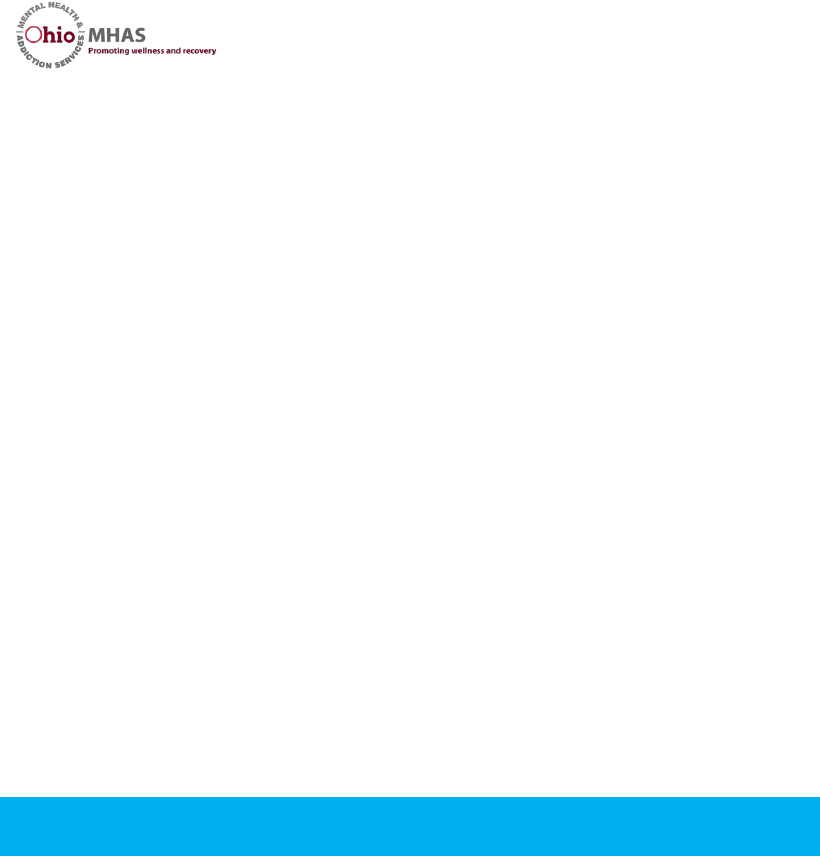
Small Business Toolkit for Adult Care Facilities Ohio Mental Health & Addiction Services Page 59 of 72
Craigslist can also be a great way to get the word out about your Adult
Care Facility.
Where Do I Find Clients?
Some good places to build relationships for potential clients include:
Mental health service providers
Discharge planners and social services professionals of local
hospitals or health care facilities, and nursing homes
Local Alcohol, Drug Addiction and Mental Health (ADMAH)
Boards
Area Agencies on Aging (AAA)
Centers for Independent Living
Departments of Social Services (state offices)
Vocational Rehabilitation providers
Physicians specializing in geriatrics, family practice or other
specialty groups related to your target population(s)
You should develop relationships with the people that work at these
agencies and leave them with information about your Adult Care
Facility.
TOOLKIT SAMPLE BUSINESS FORMS
Manual Entry Bookkeeping Tool
Resident Invoices and Payments History
12-month Income & Expense Projections (Budget)
Startup Costs Worksheet
ACF Before You Start Checklist
ACF Employment Application
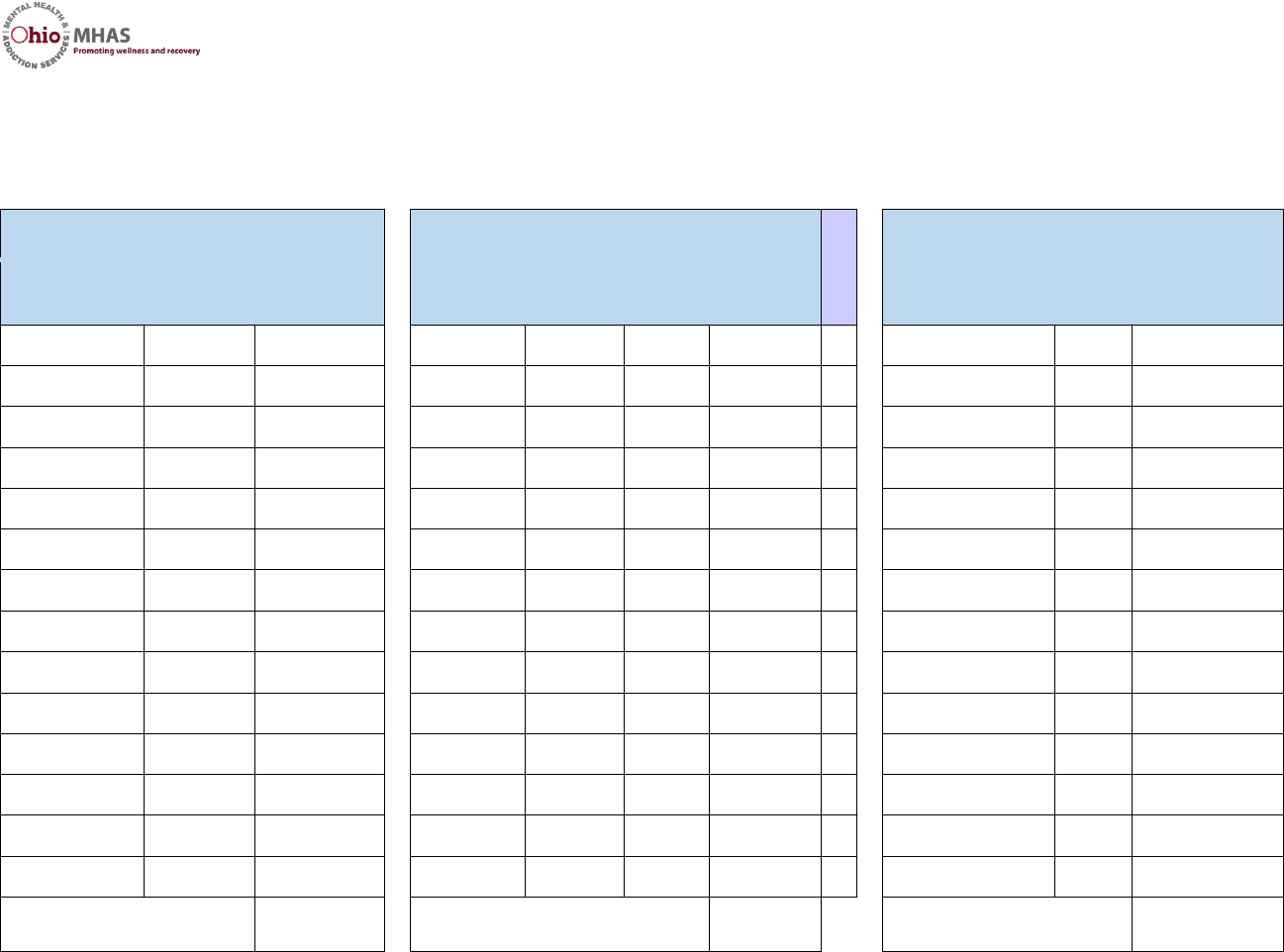
Small Business Toolkit for Adult Care Facilities Ohio Mental Health & Addiction Services Page 60 of 72
Manual Entry Bookkeeping Tool (Page 1 of 2)
Business Name:
Month of:
EXPENSES PAID BY CASH
EXPENSES PAID BY CHECK
R
MONTHLY EXPENDITURES
Date
To Whom
Amount
Date
Check #
To
Whom
Amount
Type of Expense
This
Week
Total YTD
Total Cash Spent This
Month
Total Checks Written This
Month
Total Expenses This
Month
Note: Mark “R” column once your check payment has cleared your bank.
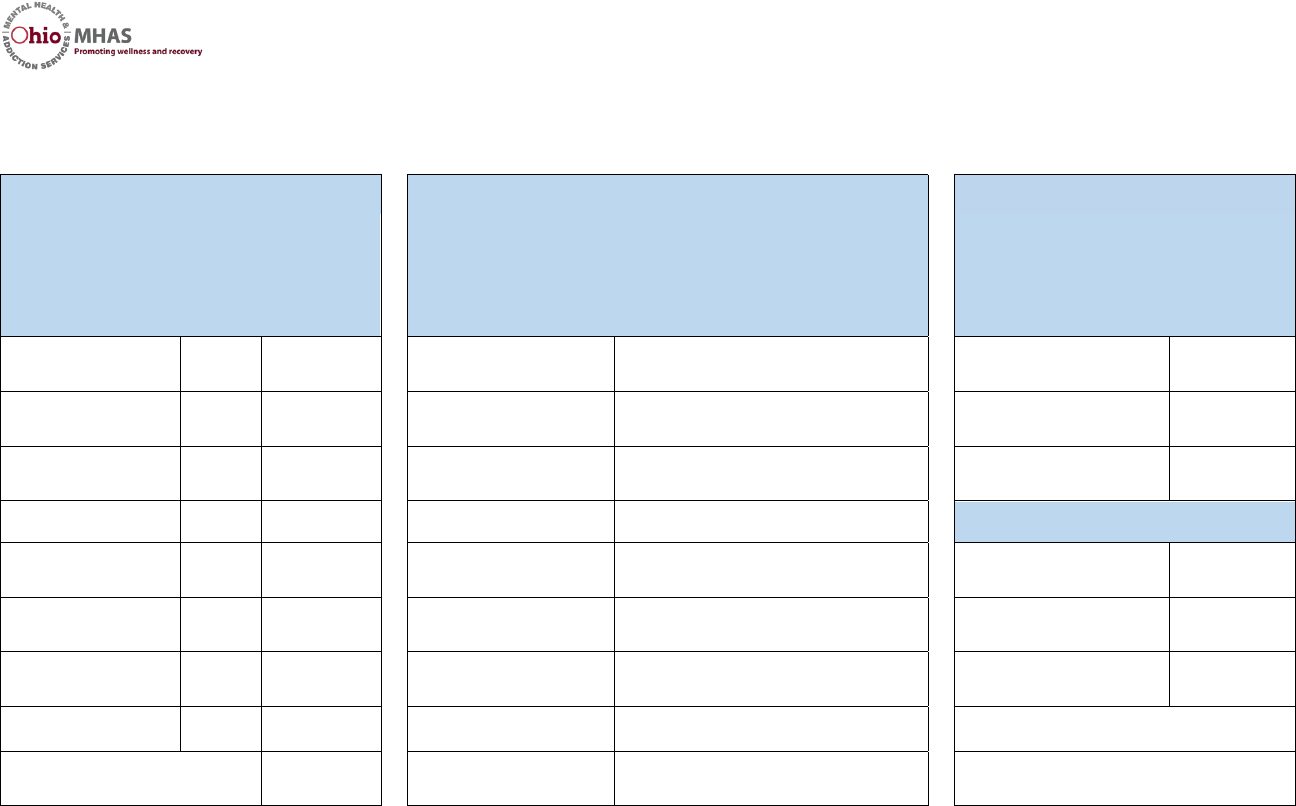
Small Business Toolkit for Adult Care Facilities Ohio Mental Health & Addiction Services Page 61 of 72
Manual Entry Bookkeeping Tool (Page 2 of 2)
MONTHLY SALES
PAYROLL OR CONTRACT LABOR
Resident Name
Third-
party
or
Private
pay
Sales/
Income
Name
Amount Paid
PROFIT AND LOSS THIS MONTH
Total Sales this
Month
Minus Total Expenses
this Month
Total Profit or Loss
this Month
PROFIT AND LOSS YEAR TO DATE
Total Sales Year-to-
Date
Minus Total Expenses
Year-to-Date
Total Profit or Loss
Year-to-Date
Total This Month
Total This Month
Total Year-to-Date
Total Year-to-Date
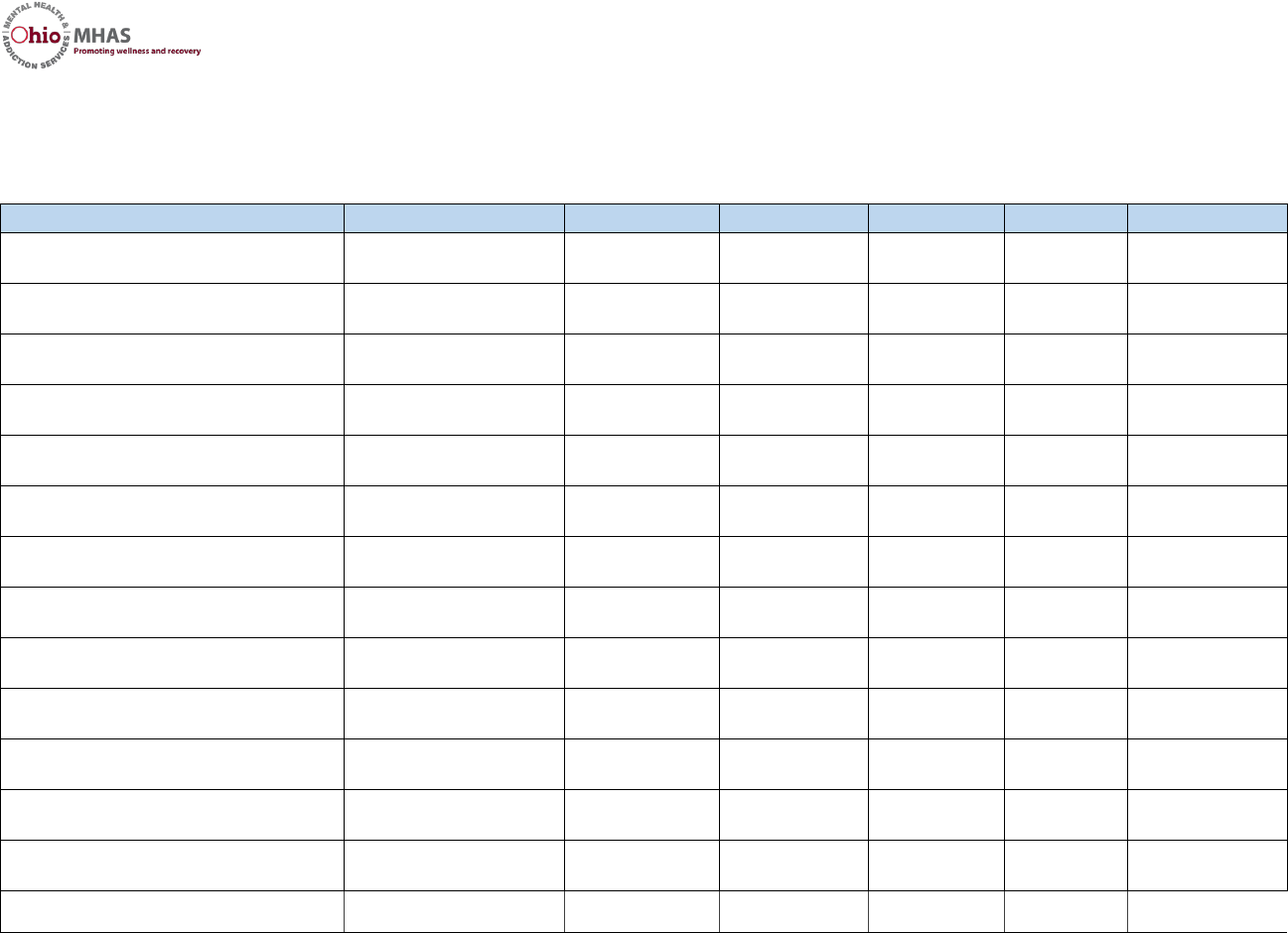
Small Business Toolkit for Adult Care Facilities Ohio Mental Health & Addiction Services Page 62 of 72
Resident Invoice & Payments Summary Report
ENTER MONTH & YEAR:
RESIDENT FULL NAME
PAYING AGENCY
AMOUNT DUE
INVOICE DATE
DUE DATE
DATE PAID
BALANCE OWED
GRAND TOTAL
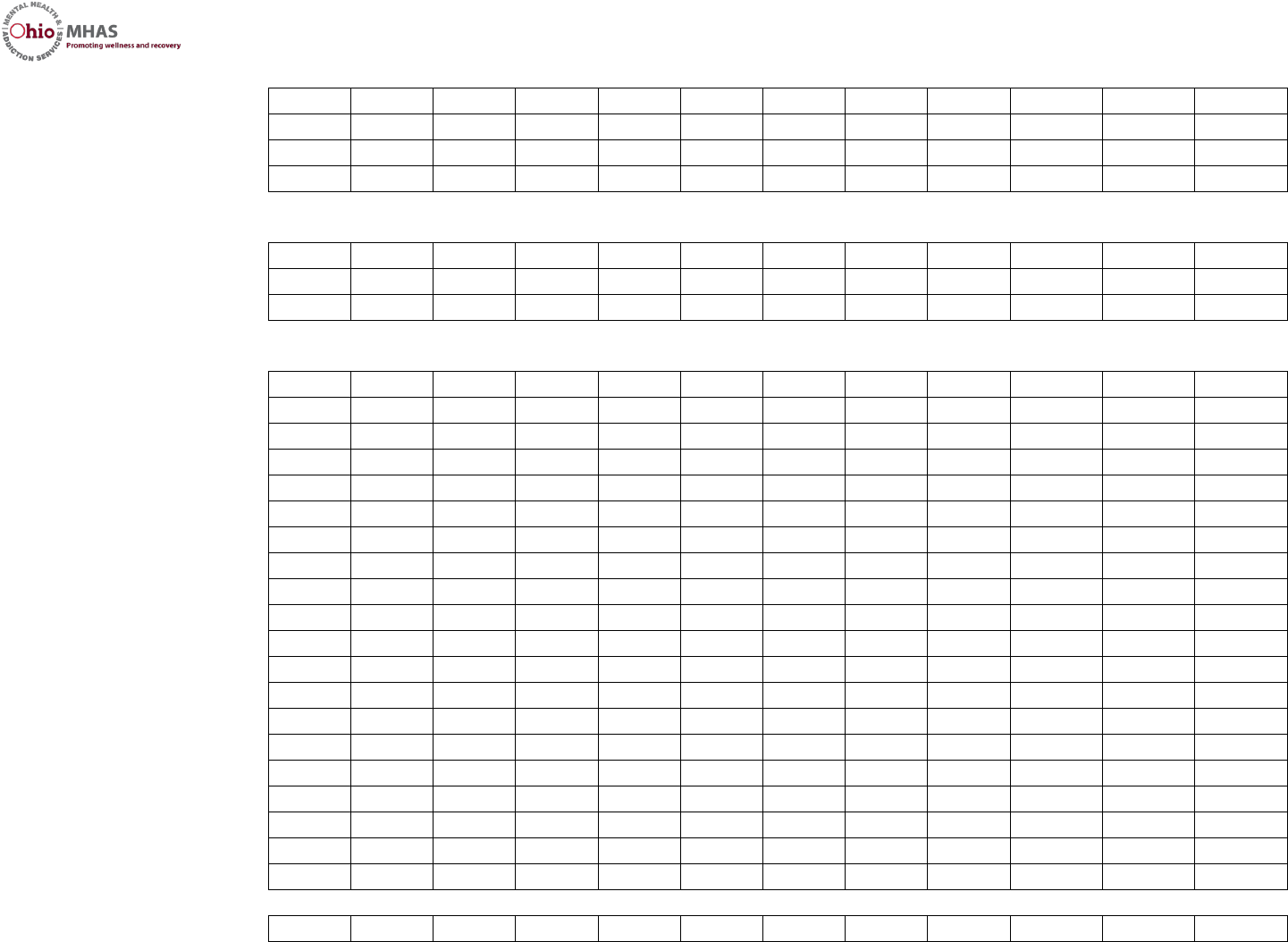
12 Months Income & Expense Projections/Budget
Small Business Toolkit for Adult Care Facilities Ohio Mental Health & Addiction Services Page 63 of 72
Mo 1
Mo 2
Mo 3
Mo 4
Mo 5
Mo 6
Mo 7
Mo 8
Mo 9
Mo 10
Mo 11
Mo 12
# of Residents RSS
# of Residents SSI/SSDI
# of Residents Private Pay
Total Paying Residents
REVENUES
Resident Income
Private Pay Income
TOTAL REVENUES
EXPENSES
Food
Resident Entertainment
Personal Supplies
Owner Salary
Employee Payroll
Payroll Taxes
Marketing
Home Maintenance
Internet
Insurance
Office Supplies
Telephone (land line)
Postage & Delivery
Rent/Mortgage Payment
Automobile expenses
Cable TV
Water
Gas
Electricity
TOTAL EXPENSES
INCOME (LOSS)
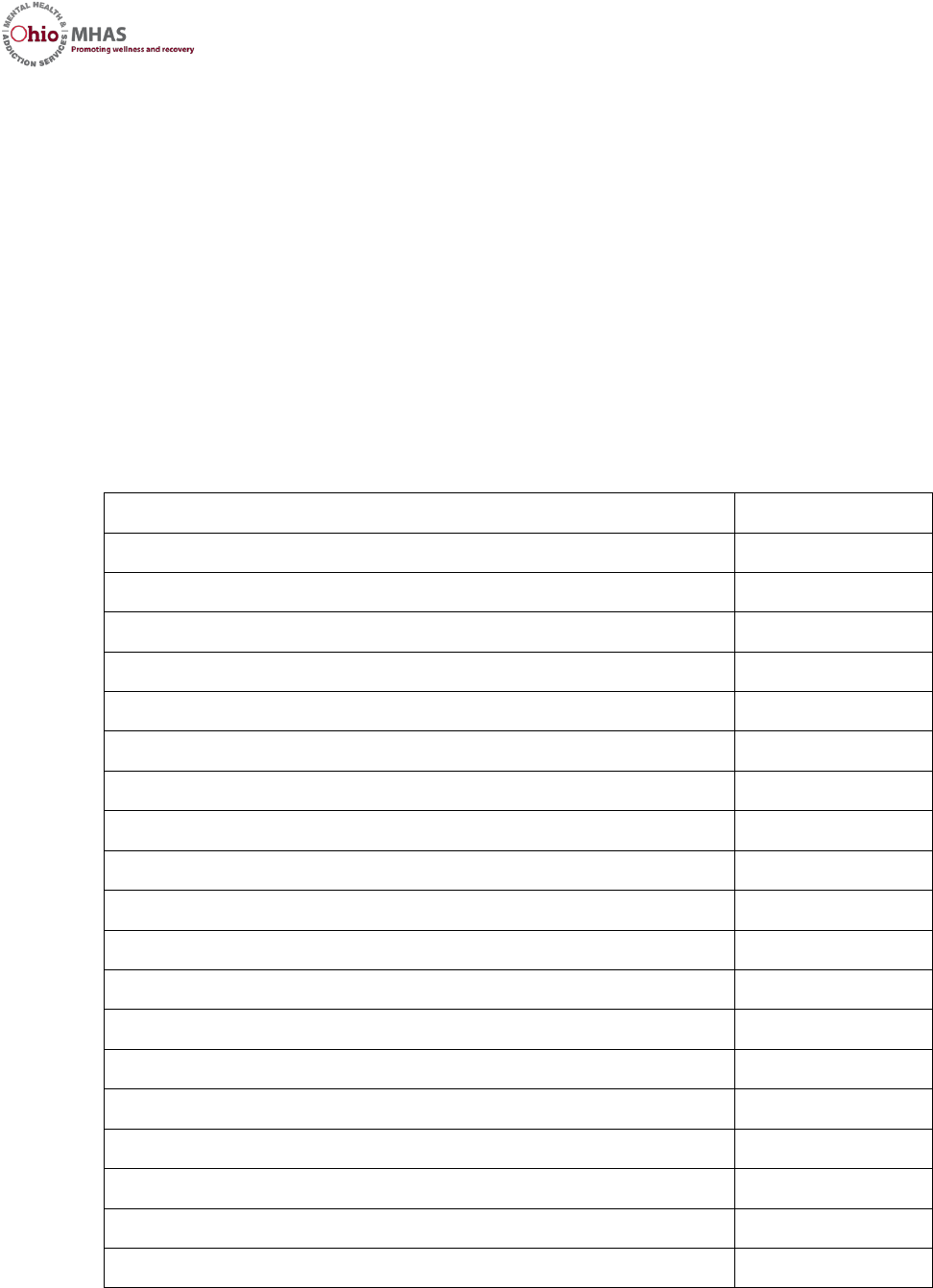
Small Business Toolkit for Adult Care Facilities Ohio Mental Health & Addiction Services Page 64 of 72
ADULT CARE FACILITY START-UP COSTS WORKSHEET
Start- Up costs are often one-time expenses and those other expenses that you need to purchase prior to opening your
business. Here are some examples:
Initial food inventory
Deposits for different services like telephone
deposit or utilities deposit
Filing fees for your licensing application
Business license fee
Costs for setting up legal structure
Pre-opening marketing
Business cards
Bedroom furniture
Consulting fees
New linens
Office supplies
Cleaning supplies
Certificate of Occupancy
Insurance payments
LIST YOUR STARTUP COSTS BELOW
Startup Costs List
Estimated Cost
1.
2.
3.
4.
5.
6.
7.
8.
9.
10.
11.
12.
13.
14.
15.
16.
17.
18.
Total Startup Costs

Small Business Toolkit for Adult Care Facilities Ohio Mental Health & Addiction Services Page 65 of 72
Adult Care Facility
Before You Start Checklist
Locate a copy of the Ohio Revised Code & the Rules of the Ohio
Administrative Code to learn the laws and rules regulating Adult Care
Facilities. Find these on the website at:
http://mha.ohio.gov/Default.aspx?tabid=333#1949350-applicable-rules-
for-adult-care-facilities
READ and learn the laws
Know the care you must provide to the residents
Obtain zoning clearance from your local Building and Zoning Services
Obtain Confirmation of Use of your home as an Adult Care Facility from the
Department of Building and Zoning Services
Use the Ohio MHAS Pre-Application Checklist to prepare your home for
inspection
Draft a budget, confirm that you have all the money needed to start this
business, AND the money needed to sustain operations long-ter
Register your business name
Determine your legal structure: sole proprietorship, partnership, limited
liability company, corporation
Get your Employer Identification Number or Tax Identification Number
from the Internal Revenue Service
Open a bank account for the Adult Care Facility income and expenses that
is separate from your personal bank account
Obtain adequate insurance to protect your business
Develop and print blank copies of all the business forms you will need for
your Adult Care Facility
Setup your business filing system
Hire the right people for your business
Learn how to run your own payroll or hire an outside payroll company
Create a marketing plan to market your business
Create, print, and monitor your business budget
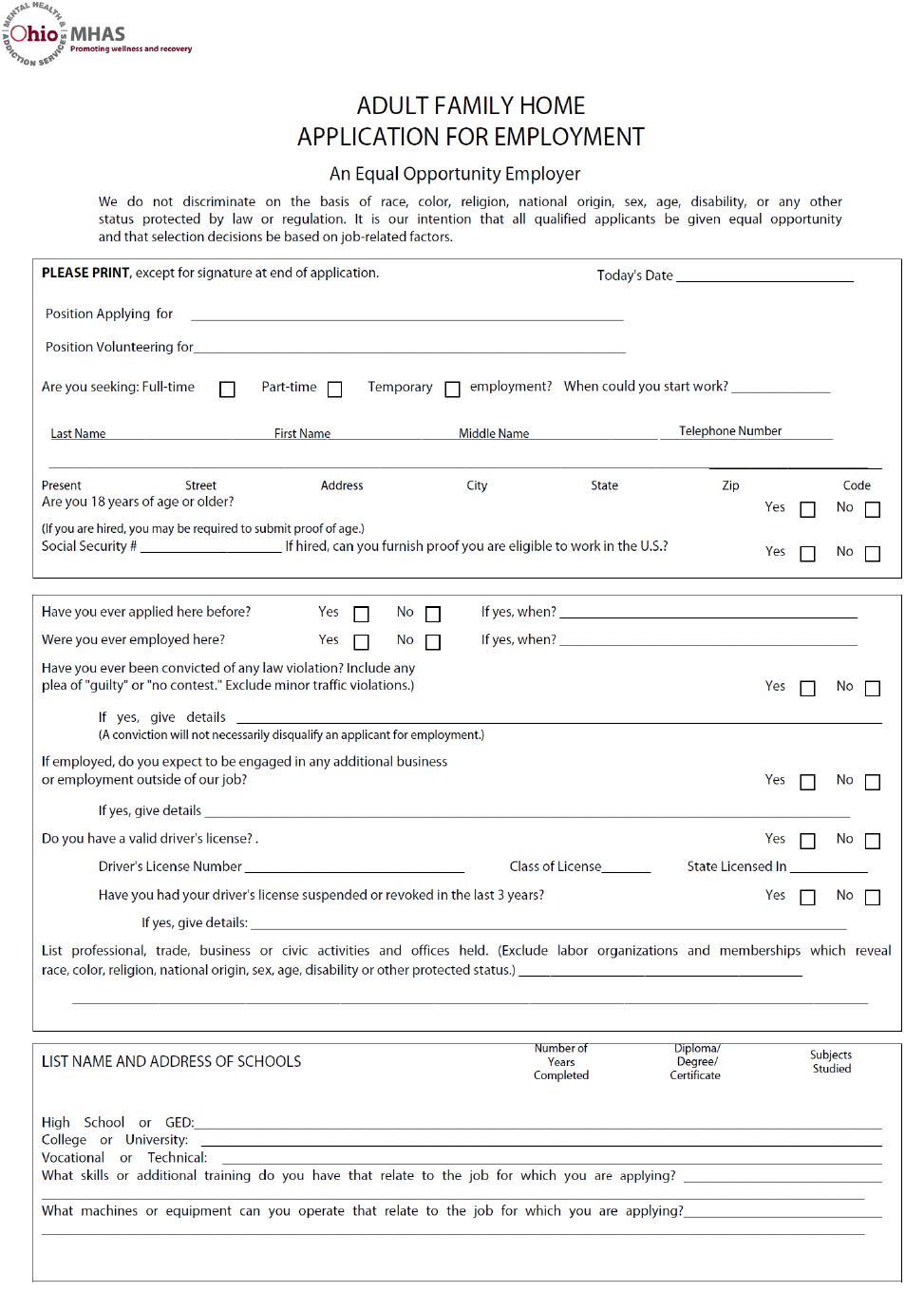
Small Business Toolkit for Adult Care Facilities Ohio Mental Health & Addiction Services Page 66 of 72
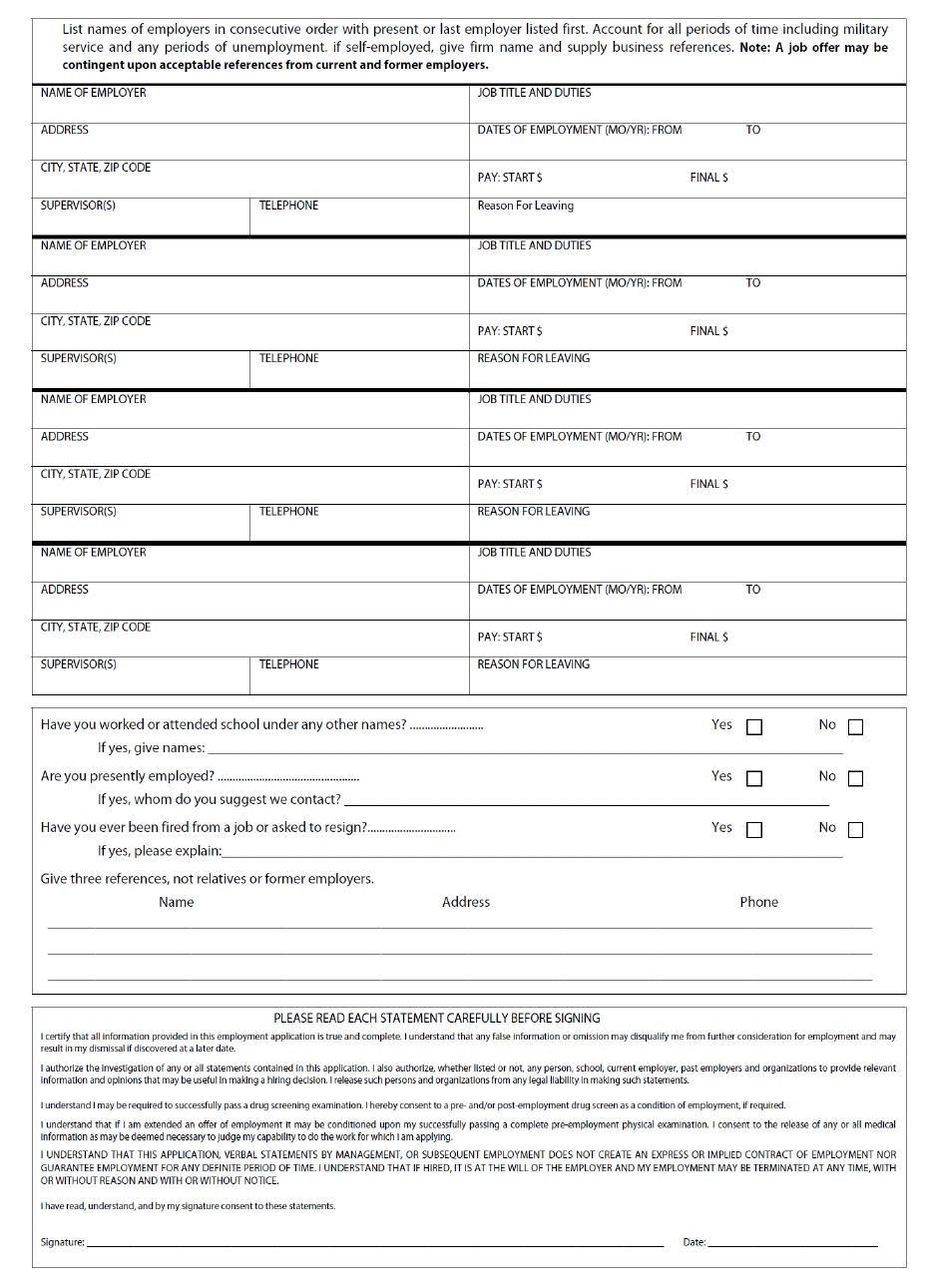
Small Business Toolkit for Adult Care Facilities Ohio Mental Health & Addiction Services Page 67 of 72
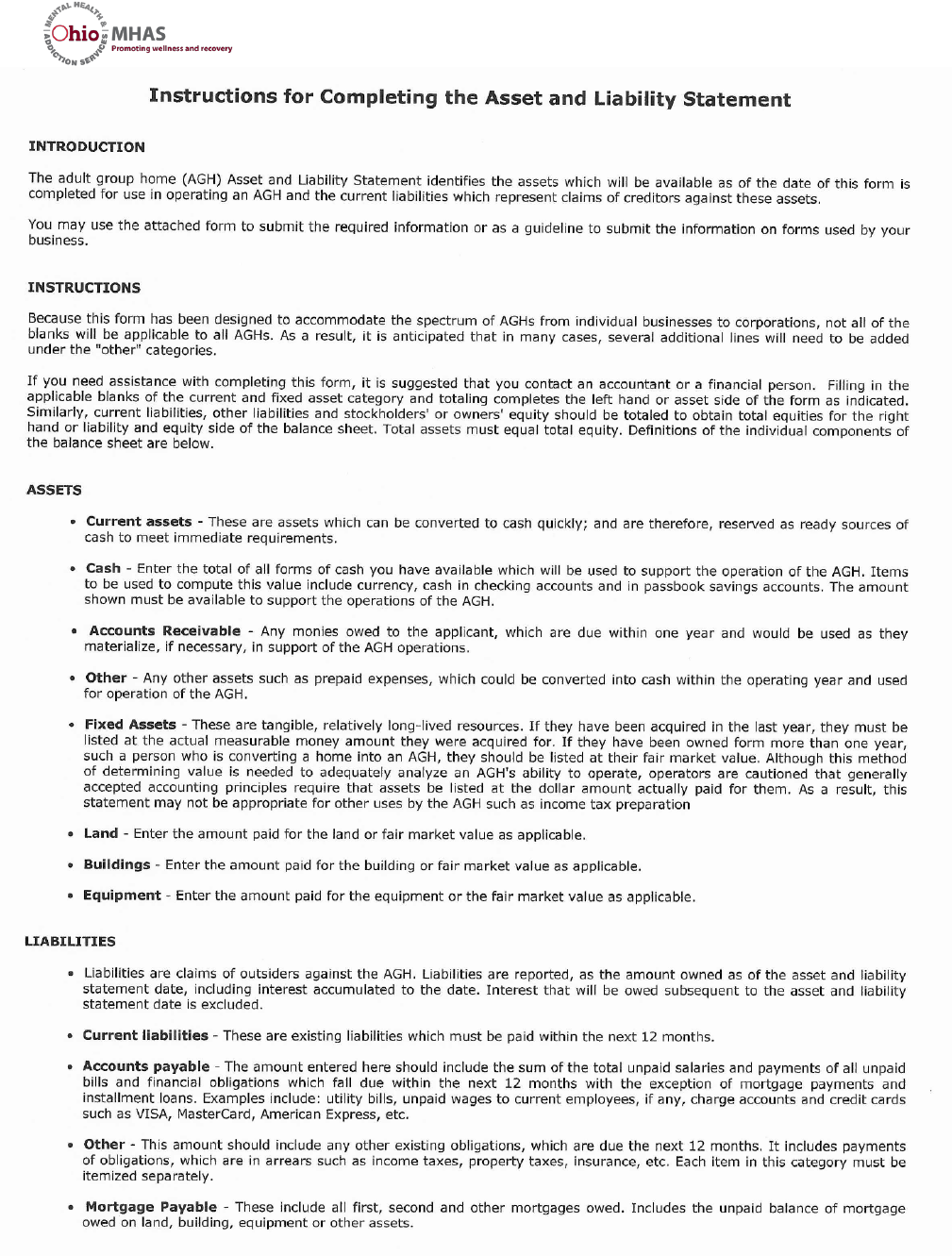
Small Business Toolkit for Adult Care Facilities Ohio Mental Health & Addiction Services Page 68 of 72
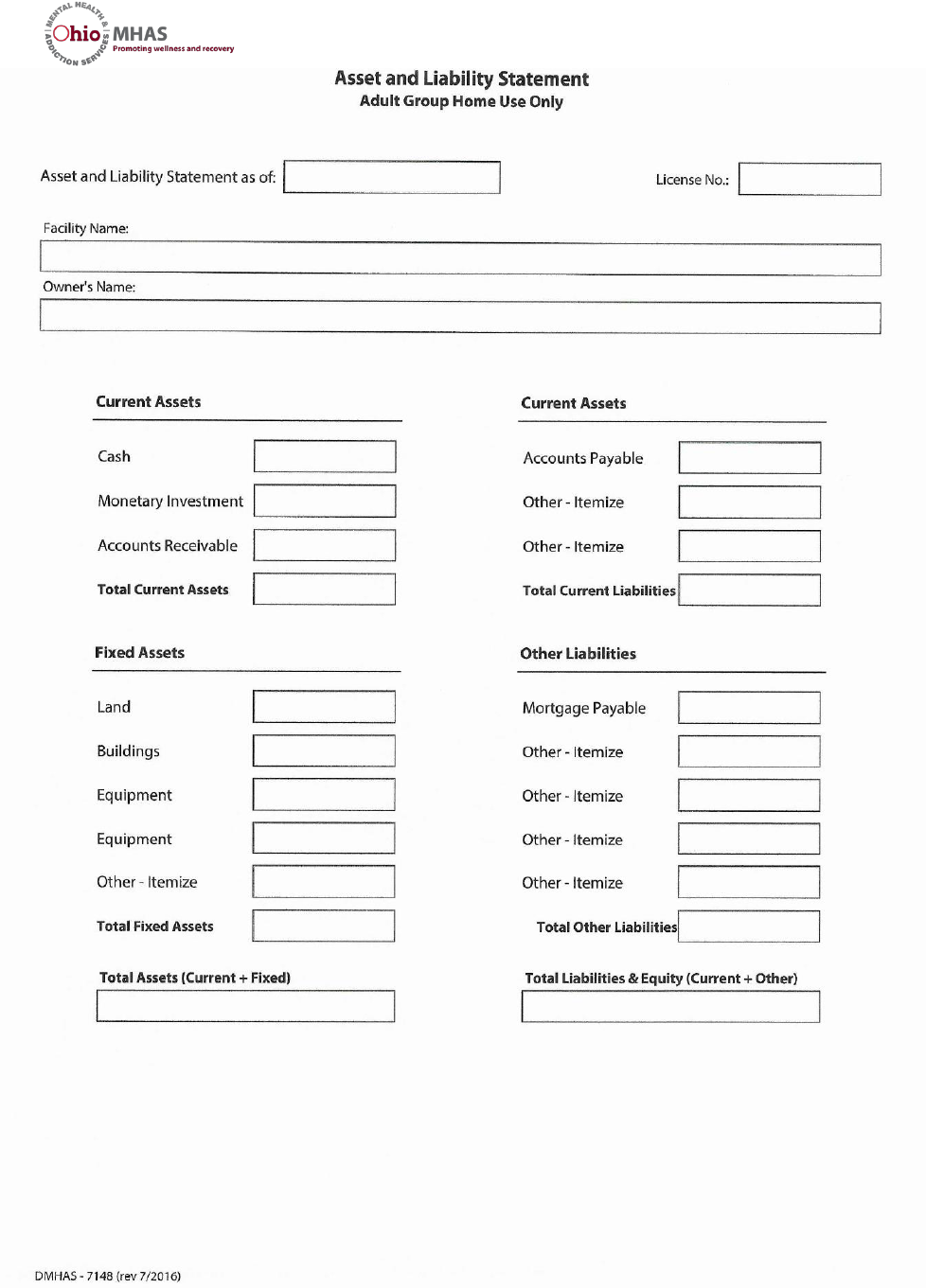
Small Business Toolkit for Adult Care Facilities Ohio Mental Health & Addiction Services Page 69 of 72
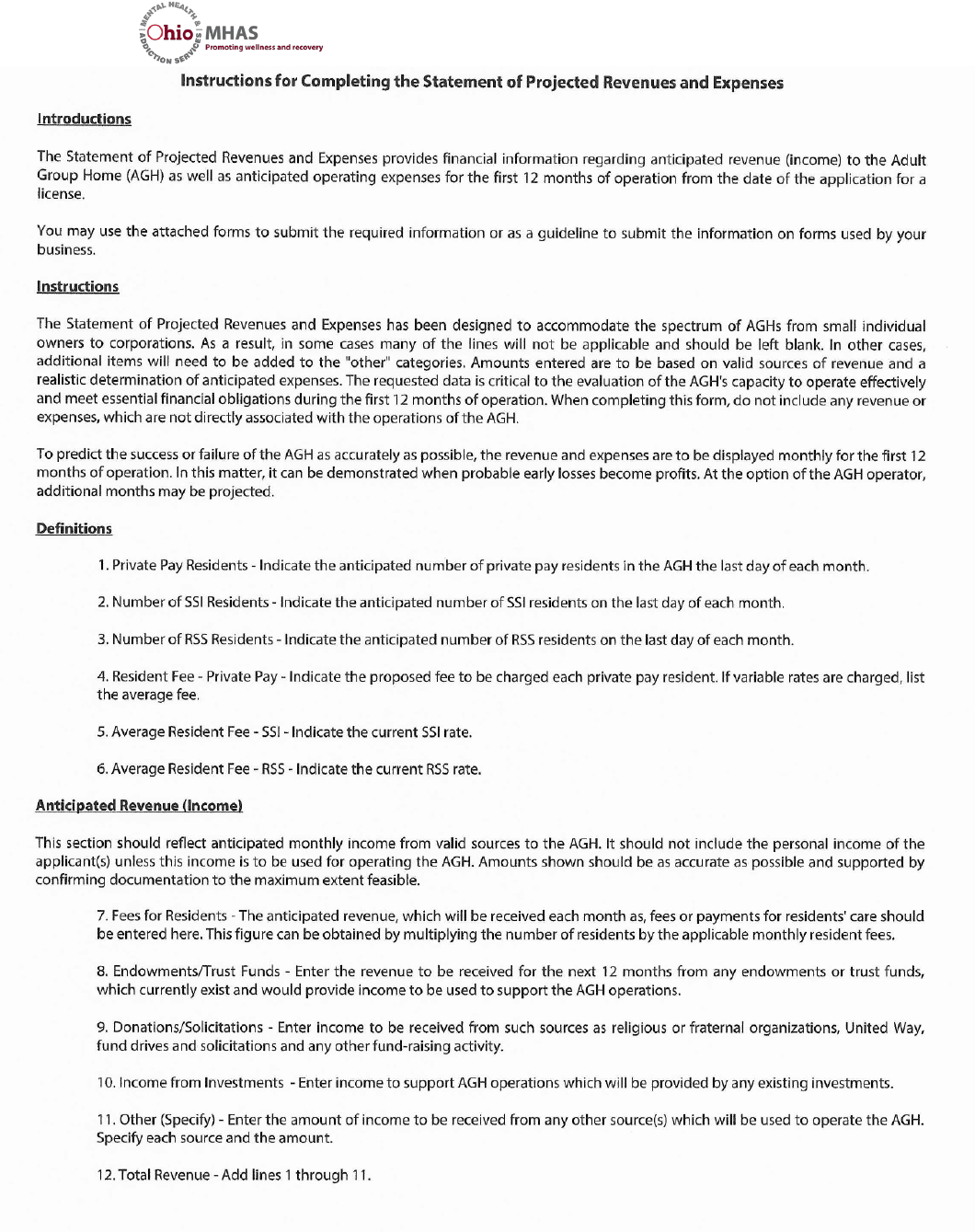
Small Business Toolkit for Adult Care Facilities Ohio Mental Health & Addiction Services Page 70 of 72
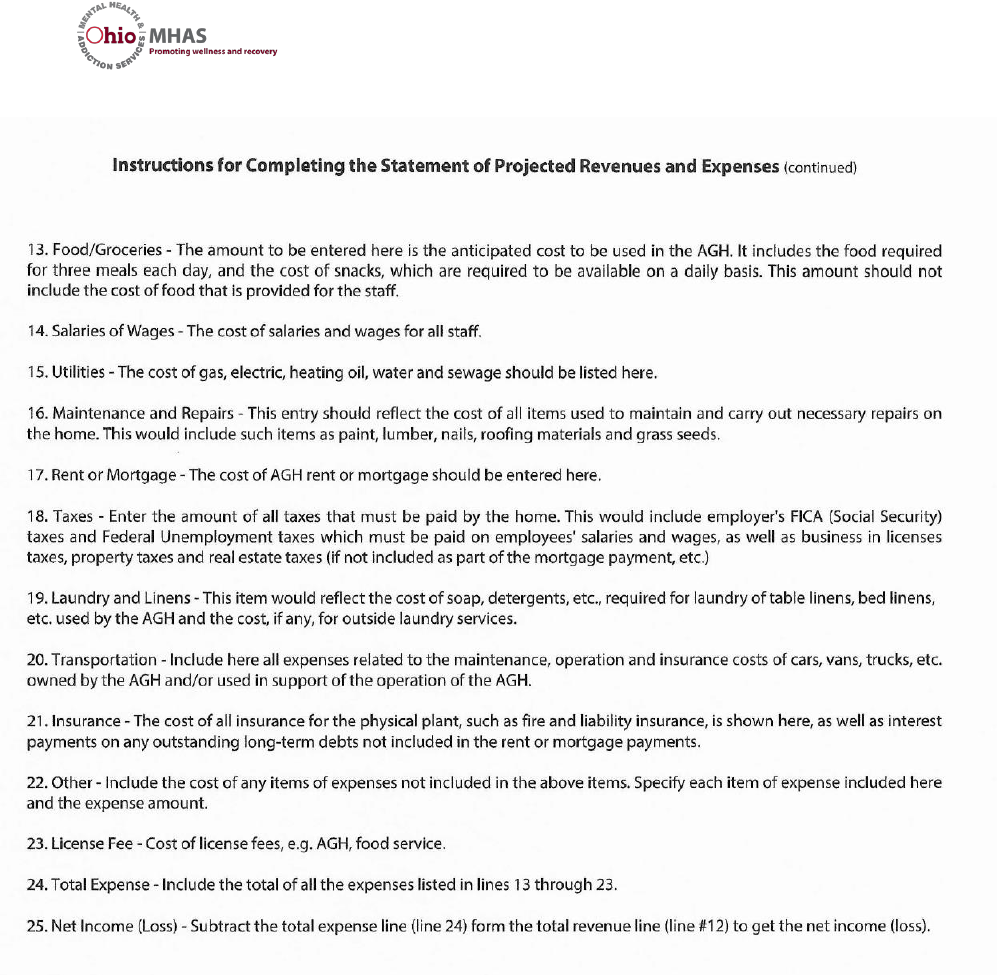
Small Business Toolkit for Adult Care Facilities Ohio Mental Health & Addiction Services Page 71 of 72
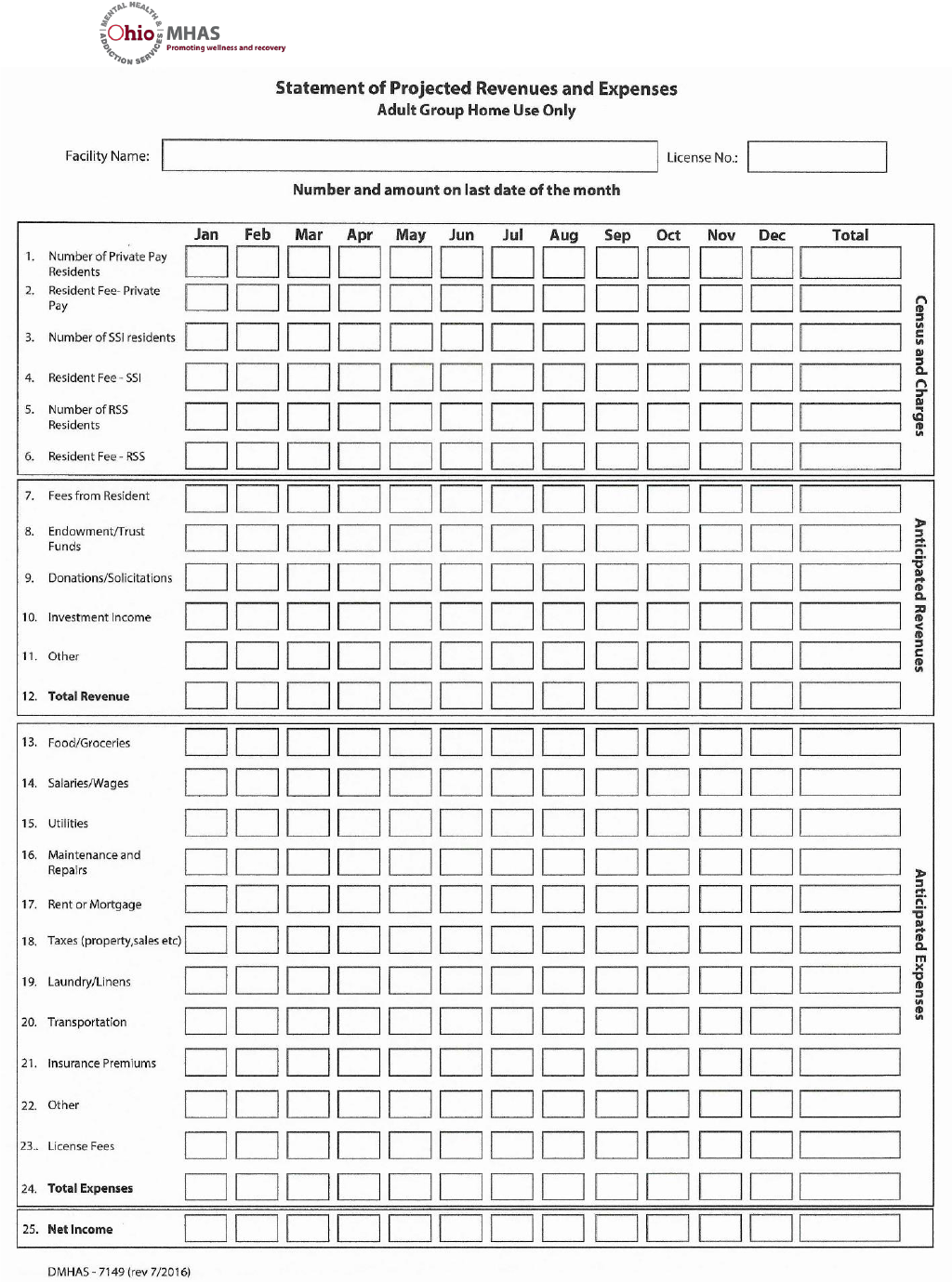
Small Business Toolkit for Adult Care Facilities Ohio Mental Health & Addiction Services Page 72 of 72
